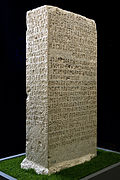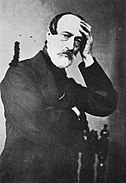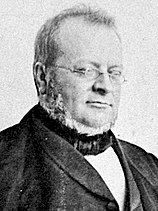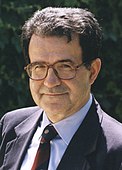History of Italy
| History ofItaly |
|---|
 |
|
|
| Part ofa serieson the |
| Culture of Italy |
|---|
 |
| People |
| Traditions |
The European country ofItalyhas been inhabited by humans since at least 850,000 years ago. Since classical antiquity, ancientEtruscans,variousItalic peoples(such as theLatins,Samnites,andUmbri),Celts,Magna Graeciacolonists, and otherancient peopleshave inhabited theItalian Peninsula.[1][2]
Italy was the birthplace and centre of theancient Roman civilisation.[3][4]Romewas founded as a kingdom in 753 BC and became a republic in 509 BC. TheRoman Republicthenunified Italyforming a confederation of the Italic peoples androseto dominate Western Europe, Northern Africa, and the Near East. After theassassination of Julius Caesar,the Roman Empire dominated Western Europe and the Mediterranean for centuries, contributing to the development of Western culture, philosophy, science and art. With thefall of Romein AD 476, Italy was fragmented into numerouscity-statesand regional polities, a situation that would remain until the complete unification of the country in 1871. Themaritime republics,in particularVeniceandGenoa,rose to prosperity.[5][6]Central Italyremained under thePapal States,whileSouthern Italyremained largelyfeudaldue to a succession ofByzantine,Arab,Norman,Spanish,andBourboncrowns.[7][8]TheItalian Renaissancespread to the rest of Europe, bringing a renewed interest inhumanism,science,exploration,andartwith the start of themodern era.[9]
By the mid-19th century,Italian unification,led by theHouse of Savoy,led to the establishment of an Italian nation-state. The newKingdom of Italyquickly modernized and built acolonial empire,controlling parts of Africa and countries along the Mediterranean. At the same time, Southern Italy remained rural and poor, originating theItalian diaspora.InWorld War I,Italy completed the unification by acquiringTrentoandTrieste,and gained a permanent seat in theLeague of Nations's executive council.Italian nationalistsconsidered World War I amutilated victorybecause Italy did not have all the territories promised by theTreaty of London (1915),and that sentiment led to the rise of thefascistdictatorship ofBenito Mussoliniin 1922. DuringWorld War II,Italy was part of theAxis powersuntil the Italian surrender toAllied powersand its occupation byNazi GermanywithFascist collaboratorsand then a co-belligerent of theAlliesduring theItalian resistanceandliberation of Italy.
Following the end of the German occupation and the killing of Benito Mussolini, the1946 Italian institutional referendumabolished the monarchy and became a republic, reinstated democracy, enjoyed aneconomic boom,and co-founded theEuropean Union(Treaty of Rome),NATO,and theGroup of Six(laterG7andG20).[10][11]
Prehistory[edit]

The arrival of the firsthomininswas 850,000 years ago atMonte Poggiolo.[12]The presence of theHomo neanderthalensishas been demonstrated in archaeological findings near Rome andVeronadating toc. 50,000years ago (latePleistocene).Homo sapiens sapiensappeared during the upperPalaeolithic.[13]Remains of the later prehistoric age includeÖtzi the Iceman,dating toc. 3400–3100BC (Copper Age).
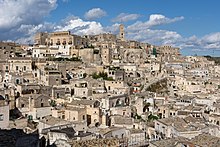
During the Copper Age, Indoeuropean people migrated to Italy in four waves. A first Indoeuropean migration occurred around the mid-3rd millennium BC, from a population who importedcoppersmithing.[15]TheRemedello culturetook over thePo Valley.The second wave occurred in theBronze Age,from the late 3rd to the early 2nd millennium BC, with tribes identified with theBeaker cultureand by the use ofbronzesmithing,in thePadan Plain,inTuscanyand on the coasts ofSardiniaandSicily.[16]In the mid-2nd millennium BC, a third wave arrived, associated with theApenninian civilizationand theTerramare culture.[17][18]The Terramare people were hunters, but had domesticated animals and cultivated crops; they were fairly skilful metallurgists, casting bronze in moulds.[19] In the late Bronze Age, from the late 2nd millennium to the early 1st millennium BC, a fourth wave, theProto-Villanovan culture,brought iron-working to the Italian peninsula. Proto-Villanovan culture may have been part of the central EuropeanUrnfield culturesystem,[20][21]or a derivation from Terramare culture.[22][23]Various authors, such asMarija Gimbutas,associated this culture with the spread of the proto-Italicsinto theItalian Peninsula.[20]
Nuragic civilization[edit]
Born inSardiniaandsouthern Corsica(where it is calledTorrean civilization), theNuraghecivilization lasted from the 18th century BC to the 2nd century AD.[24][25][26][27]They take their name from the characteristic Nuragic towers, which evolved from the pre-existing megalithic culture, which builtdolmensandmenhirs.[28]Today more than 7,000 nuraghes[29]appear in Sardinia.
No written records of this civilization have been discovered,[30]apart from a few possible short epigraphic documents.[31]The only written information comes from classical literature of theGreeksandRomans,and may be considered more mythological than historical.[32]The language (or languages) spoken in Sardinia during the Bronze Age is (are) unknown since there are no written records from the period, although research suggests that around the 8th century BC the Nuragic populations may have adopted an Alpha bet similar to that used inEuboea.[33]
-
Bronze sculpture of a Nuragic chief fromUta
Iron Age[edit]
Etruscan civilization[edit]
TheEtruscan civilizationflourished in central Italy after 800 BC. The main hypotheses on the origins of theEtruscansare that they are indigenous,[34]probably stemming from theVillanovan culture,or that they are the result of invasion from the north or theNear East.A 2007 study has suggested aNear Easternorigin.[35]The researchers conclude that their data, taken from the modern Tuscan population, "support the scenario of a post-Neolithic genetic input from the Near East to the present-day population of Tuscany". In the absence of any dating evidence, there is however no direct link between this genetic input and the Etruscans. By contrast, amitochondrial DNAstudy of 2013 has suggested that the Etruscans were probably an indigenous population. Among ancient populations, ancient Etruscans are found to be closest to a Neolithic population from Central Europe.[34]
It is widely accepted that Etruscans spoke a non-Indo-European language.Some inscriptions in a similar language, known asLemnian,have been found on the Aegean island ofLemnos.Etruscans were a monogamous society that emphasized pairing. The historical Etruscans had achieved a form of state with remnants of chiefdom and tribal forms. The first attestations of anEtruscan religioncan be traced to theVillanovan culture.[36]
Etruscan expansion was focused across theApennines.The political structure of the Etruscan culture was similar, albeit more aristocratic, to Magna Graecia in the south. The mining and commerce of metal, especially copper and iron, led to an enrichment of the Etruscans and to the expansion of their influence in the Italian peninsula and the westernMediterranean.Here their interests collided with those of the Greeks, especially in the 6th century BC, whenPhoceansof Italy founded colonies along the coast of France, Catalonia andCorsica.This led the Etruscans to ally themselves with theCarthaginians.[37][38]
Around 540 BC, theBattle of Alalialed to a new distribution of power in the western Mediterranean.Carthageexpanded its sphere of influence at the expense of the Greeks, andEtruriasaw itself relegated to Corsica. From the first half of the 5th century, the new international political situation meant the beginning of the Etruscan decline. In 480 BC, Etruria's ally Carthage was defeated by a coalition of Magna Graecia cities led bySyracuse.[37][38]
A few years later, in 474 BC, Syracuse's tyrantHierodefeated the Etruscans at theBattle of Cumae.Etruria's influence over the cities ofLatiumand Campania weakened, and it was taken over by Romans andSamnites.In the 4th century, Etruria saw aGallicinvasion end its influence over thePovalley and theAdriaticcoast. Meanwhile,Romehad started anne xing Etruscan cities. This led to the loss of their north provinces.Etrusciawas assimilated by Rome around 500 BC.[37][38]
-
Necropolis of Banditaccia located inCerveteri,Lazio
Italic peoples[edit]
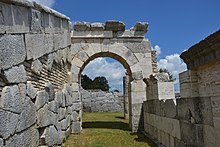

The Italic peoples were anethnolinguistic groupidentified by use ofItalic languages.Among the Italic peoples in the Italian peninsula were theOsci,theVeneti,theSamnites,theLatinsand theUmbri.[39]
In the region south of theTiber(Latium Vetus), theLatial cultureof theLatinsemerged, while in the north-east of the peninsula theEste cultureof theVenetiappeared. Roughly in the same period, from their core area in central Italy (modern-dayUmbriaandSabina), theOsco-Umbriansbegan to emigrate in various waves, through the process ofVer sacrum,the ritualized extension of colonies, in southern Latium,Moliseand the whole southern half of the peninsula, replacing the previous tribes, such as theOpiciand theOenotrians.This corresponds with the emergence of the Terni culture, which had strong similarities with the Celtic cultures of Hallstatt andLa Tène.[40]
Before and during the period of the arrival of the Greek and Phoenician immigrants, Sicily was already inhabited by native Italics in three major groups: theElymiansin the west, theSicaniin the centre, and theSicels(source of the name Sicily) in the east.[41]
It is generally believed that around2000 BC,theLiguresoccupied a large area of the peninsula, including much of north-western Italy and all of northern Tuscany. Since many scholars consider thelanguageof this ancient population to bePre-Indo-European,they are often not classified as Italics.[42]
By the mid-first millennium BCE, the Latins ofRomewere growing in power and influence. After the Latins had liberated themselves from Etruscan rule they acquired a dominant position among the Italic tribes. Frequent conflict between various Italic tribes followed; the best documented are theSamnite Wars.[43]The Latins eventually succeeded in unifying the Italic elements in the country. In the early first century BCE, several Italic tribes, in particular theMarsiand the Samnites, rebelled against Roman rule (theSocial War). After Roman victory was secured, all peoples in Italy, except for theCeltsof the Po Valley, were grantedRoman citizenship.In the subsequent centuries, Italic tribes adoptedLatinlanguage and culture in a process known asRomanization.[43]
Magna Graecia[edit]
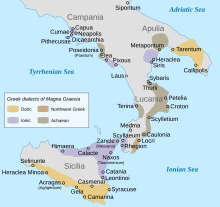
In the eighth and seventh centuries BC, for reasons including demographic crisis, the search for new commercial outlets and ports, and expulsion from their homeland, Greeks began to settle along the coast of Sicily and the southern part of the Italian peninsula, which became known asMagna Graecia.[45]
Greek culturewas exported to Italy, in its dialects of theAncient Greek language,its religious rites and its traditions of the independentpolis.An originalHellenic civilizationsoon developed, later interacting with the nativeItalicandLatin civilisations.The most important cultural transplant was theChalcidean/Cumaeanvariety of theGreek Alpha bet,which was adopted by theEtruscans;theOld Italic Alpha betsubsequently evolved into theLatin Alpha bet.
Many of the new Hellenic cities became very rich and powerful, likeNeapolis(Naples),Syracuse,Acragas,andSybaris.Other cities in Magna Graecia includedTarentum,Epizephyrian Locri,Rhegium,Croton,Thurii,Elea,Nola,Ancona,Syessa,Bari,and others.
AfterPyrrhus of Epirusfailed to stop the spread of Roman hegemony in 282 BC, the south fell under Roman domination. It was held by theByzantine Empireafter thefall of Romeinthe Westand even theLombardsfailed to consolidate it, though the centre of the south was theirs fromZotto's conquest in the final quarter of the 6th century.[46]
Roman period[edit]
Roman Kingdom[edit]
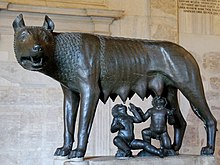
Little is certain about the history of the Roman Kingdom, as nearly no written records from that time survive, and the histories written during theRepublicandEmpireare largely based on legends. According to thefounding mythof Rome, the city wasfoundedon 21 April 753 BC by twin brothersRomulus and Remus,who descended from theTrojanprinceAeneas[47]and who were grandsons ofNumitorofAlba Longa.
The traditional account of Roman history, which has come down throughLivy,Plutarch,Dionysius of Halicarnassus,and others, is that in Rome's first centuries, it was ruled by a succession of seven kings. TheGaulsdestroyed much of Rome's historical records when they sacked the city after theBattle of the Alliain 390 or 387 BC. With no contemporary records, all accounts of the kings must be carefully evaluated.[48]
Roman Republic[edit]

According to tradition and later writers such asLivy,theRoman Republicwas established around 509 BC,[49]when the last of the seven kings of Rome,Tarquin the Proud,was deposed byLucius Junius Brutus.A system based on annually electedmagistratesand various representative assemblies was established.[50]Aconstitutionset a series of checks and balances, and aseparation of powers.The most important magistrates were the two consuls, who together exercised executive authority asimperium,or military command.[51]The consuls had to work with thesenate,which was initially an advisory council of the ranking nobility, orpatricians,but grew in size and power.[52]
In the 4th century BC, the Republic came under attack by theGauls,who initially prevailed and sacked Rome. The Romans then drove the Gauls back, led byCamillus.The Romansgradually subduedthe other peoples on the peninsula.[53]The last threat to Romanhegemonyin Italy came whenTarentum,a majorGreekcolony, enlisted the aid ofPyrrhus of Epirusin 281 BC, but this effort failed.[54][55]
In the 3rd century BC, Rome had to face a new and formidable opponent:Carthage.In the threePunic Wars,Carthage was eventually destroyed and Rome gained control over Hispania, Sicily and North Africa. After defeating theMacedonianandSeleucid Empiresin the 2nd century BC, the Romans became the dominant people of the Mediterranean.[56][57]The conquest of the Hellenistic kingdoms provoked a fusion between Roman and Greek cultures and the Roman elite, once rural, became a luxurious and cosmopolitan one. By this time Rome was a consolidated empire – in the military view – and had no major enemies. Roman armies occupied Spain in the early 2nd century BC but encountered stiff resistance. TheCeltiberianstronghold ofNumantiabecame the centre of Spanish resistance in the 140s and 130s BC.[58]Numantia fell and was razed to the ground in 133 BC. In 105 BC, the Celtiberians drove theCimbriandTeutonesfrom northern Spain,[59]though these hadcrushed Roman armsin southern Gaul, inflicting 80,000 casualties on the Roman army. Theconquest of Hispaniawas completed in 19 BC—but at a heavy cost.[60]

Towards the end of the 2nd century BC, a huge migration ofGermanictribes took place, led by the Cimbri and the Teutones. These tribes overwhelmed the peoples with whom they came into contact and threatened Italy. At theBattle of Aquae Sextiaeand theBattle of Vercellaethe Germans were virtually annihilated. In these two battles the Teutones andAmbronesare said to have lost 290,000 men, and the Cimbri 220,000.[61]
In the mid-1st century BC, the Republic faced a period of political crisis and social unrest.Julius Caesarreconciled the two more powerful men in Rome:Marcus Licinius CrassusandPompey.[62]In 53 BC, the Triumvirate disintegrated at the death of Crassus. After being victorious in theGallic Wars,Caesarcrossed the Rubiconand invaded Rome in 49 BC, rapidly defeating Pompey. Caesar was eventually granted a dictatorship for perpetuity but was murdered in 44 BC.[63]Caesar's assassination caused political and social turmoil; without the dictator's leadership, Rome was ruled by his friend and colleague,Mark Antony.Octavian(Caesar's adopted son), along with Antony andMarcus Aemilius Lepidus,[64]established theSecond Triumvirate.Lepidus was forced to retire in 36 BC after betraying Octavian inSicily.Antony settled in Egypt with his lover,Cleopatra VII,which was seen as an act of treason.[65]
Following Antony'sDonations of Alexandria,which gave Cleopatra the title of "Queen of Kings", and to their children the regal titles to the newly conquered Eastern territories, war between Octavian and Mark Antony broke out. Octavian annihilated Egyptian forces in theBattle of Actiumin 31 BC. Mark Antony and Cleopatra committed suicide. Rome thus possessed unchallengednavalsupremacy in theNorth Sea,Atlanticcoasts, Mediterranean,Red Sea,and theBlack Sea.
Roman Empire[edit]
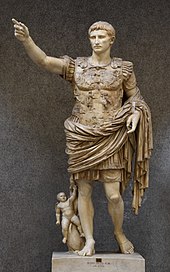
Octavian's leadership brought thezenithof the Roman civilization, which lasted for four decades. His adoption of the nameAugustusin 27 BC is usually taken by historians as the beginning of the Roman Empire. Officially, the government was republican, but Augustus assumed absolute powers.[67][68]The Senate granted Octavian a unique grade ofProconsularimperium,which gave him authority over all Proconsuls (military governors).[69]The unrulyimperial provincesat the borders, where the vast majority of the legions were stationed, were under the control of Augustus. The peacefulsenatorial provinceswere under the control of the Senate. The Roman legions, which had reached an unprecedented number (around 50) because of the civil wars, were reduced to 28.[70]
Asprovinceswere being established throughout the Mediterranean,Roman Italymaintained a special status which made itDominaProvinciarum( "ruler of the provinces" ),[71][72][73]and – especially in relation to thefirst centuries of imperial stability–Rectrix Mundi( "governor of the world" )[74][75]andOmnium Terrarum Parens( "parent of all lands" ).[76][77]Such a status meant that, within Italy in times of peace, Roman magistrates exercised theImperiumdomi(police power) as an alternative to theImperium militiae(military power). Italy's inhabitants hadLatin Rightsas well as religious and financial privileges.

Roman literature grew steadily in theGolden Age of Latin Literature,with poets likeVergil,Horace,OvidandRufus.Augustus also continued the shifts on the calendar promoted by Caesar, and the month of August is named after him.[78]Augustus' enlightened rule resulted in 200 years of peace for the Empire, known asPax Romana.[79]
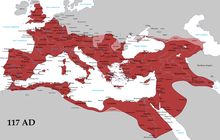
Despite its military strength, the Empire made few efforts to expand, the most notable being theconquest of Britain,begun by emperorClaudius(47), and emperorTrajan's conquest ofDacia(101–102, 105–106). In the 1st and 2nd centuries, Roman legions were also employed inintermittent warfare with the Germanic tribesto the north and theParthian Empireto the east. Meanwhile, armed insurrections (e.g. the Hebraic insurrection inJudea,70) and brief civil wars (e.g. in 68 AD theyear of the four emperors) demanded the legions' attention. The seventy years ofJewish–Roman warsin the second half of the 1st century and the first half of the 2nd century were exceptional in their duration and violence.[80]An estimated 1,356,460 Jews were killed as a result of theFirst Jewish Revolt;[81]theSecond Jewish Revolt(115–117) led to the death of more than 200,000 Jews;[82]and theThird Jewish Revolt(132–136) resulted in the death of 580,000 Jewish soldiers.[83]
After the death ofTheodosius I(395), the Empire was divided into anEasternand aWestern Roman Empire.The Western part faced increasing economic and political crises and frequent barbarian invasions, so the capital was moved fromMediolanumtoRavenna.In 476, the last Western EmperorRomulus Augustuluswas deposed byOdoacer.
Middle Ages[edit]
Odoacer's rule ended when theOstrogoths,under the leadership ofTheodoric,conquered Italy. Decades later, the armies of Eastern EmperorJustinianentered Italy with the goal of re-establishing imperial Roman rule, which led to theGothic Warthat devastated the whole country with famine and epidemics. This ultimately allowed another Germanic tribe, theLombards,to take control over vast regions of Italy. In 751 the Lombards seizedRavenna,ending Byzantine rule in northern Italy. Facing a new Lombard offensive, the Papacy appealed to theFranksfor aid.[84]

In 756 Frankish forces defeated the Lombards and gave the Papacy legal authority over much of central Italy, establishing thePapal States.In 800,Charlemagnewas crowned emperor of theHoly Roman Empire.After the death of Charlemagne (814), the new empire disintegrated under his weak successors, resulting in a power vacuum in Italy and coinciding with the rise of Islam in North Africa and the Middle East. In the South, there were attacks from theUmayyad Caliphateand theAbbasid Caliphate.In the North, there was a rising power ofcommunes.In 852, the Saracens tookBariand founded anemiratethere. Islamic rule over Sicily was effective from 902.
In the 11th century, trade slowly recovered as the cities started to grow again and the Papacy regained its authority. TheInvestiture controversy,over whether secular authorities had any legitimate role in appointments to ecclesiastical offices, was resolved by theConcordat of Wormsin 1122, although problems continued in many areas of Europe until the end of the medieval era. In the north, aLombard Leagueof communes launched a successful effort to win autonomy from the Holy Roman Empire, defeating EmperorFrederick Barbarossaat theBattle of Legnanoin 1176. In the south, theNormansoccupied the Lombard and Byzantine possessions.[85] The few independent city-states were also subdued. During the same period, the Normans ended Muslim rule in Sicily. In 1130,Roger II of Sicilybegan his rule as the first king of the NormanKingdom of Sicily;he had succeeded in uniting all the Norman conquests in Southern Italy into one kingdom with a strong centralized government. In 1155, EmperorManuel Komnenosattempted to regain Southern Italy, but the attempt failed and in 1158 the Byzantines left Italy. The Norman Kingdom lasted until 1194 when Sicily was claimed by the GermanHohenstaufen Dynasty.
Between the 12th and 13th centuries, Italy developed a peculiar political pattern, significantly different from feudal Europe north of the Alps. The oligarchiccity-statebecame the prevalent form of government. Keeping direct Church control and Imperial power at arm's length, the many independent city-states prospered through commerce, ultimately creating the conditions for the artistic and intellectual changes produced by theRenaissance.[86][87]Northern cities and states were notable for theirmerchant republics,especially theRepublic of Venice.[88]Compared to feudal and absolute monarchies, the merchant republics enjoyed relative political freedom.[89]
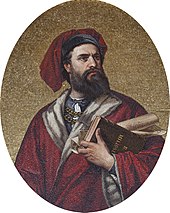
During this period, many Italian cities developed republican forms of government, such as the republics ofFlorence,Lucca,Genoa,VeniceandSiena.During the 13th and 14th centuries these cities became major financial and commercial centres.[91]Milan, Florence and Venice, among other city-states, played a crucial innovative role in financial development, devising the main instruments and practices of banking and new forms of social and economic organization.[89]
During the same period, Italy saw the rise of theMaritime Republics:Venice,Genoa,Pisa,Amalfi,Ragusa,Ancona,GaetaandNoli.[92]From the 10th to the 13th centuries these cities built fleets of ships for their own protection and to support extensive trade networks across the Mediterranean, leading to an essential role in theCrusades.The maritime republics, especially Venice and Genoa, soon became Europe's main gateways to trade with the East, establishing colonies as far as theBlack Seaand often controlling most of the trade with theByzantine Empireand the Islamic Mediterranean world. Thecounty of Savoyexpanded its territory into the peninsula in thelate Middle Ages,while Florence developed into a highly organized commercial and financial city-state, becoming for many centuries the European capital of silk, wool, banking and jewellery. Central and southern Italy was far poorer than the north. Rome was largely in ruins, and thePapal Stateswere a loosely administered region with little law and order. Partly because of this, the Papacyhad relocated to Avignonin France. Naples, Sicily, and Sardinia had for some time been under foreign domination. TheBlack Deathin 1348 killed perhaps one-third of Italy's population.[93]
-
TheLombard Kingdomin 740, under KingLiutprand
-
Emirate of Sicily(831–1072)
-
Location and coat of arms of theMaritime republics
Renaissance[edit]
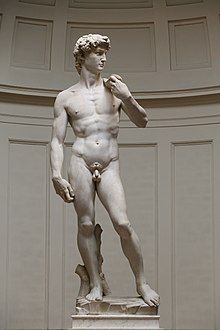

The recovery from the demographic and economic disaster of the late Middle Ages led to a resurgence of cities, trade and economy. Italy was the main centre of the Renaissance, whose flourishing of the arts, architecture, literature, science, historiography, and political theory influenced all of Europe.[94][95]The Renaissance represented a "rebirth" not only of economy and urbanization but also of arts and science, fuelled by rediscoveries of ancient texts and the migration west into Italy of intellectuals fleeing theEastern Roman Empire.Thefall of Constantinopleled to the migration ofGreek scholarsand texts to Italy, fueling the rediscovery of Greco-RomanHumanism.[96][97][98]Humanist rulers such asFederico da MontefeltroandPope Pius IIworked to establishideal cities,foundingUrbinoandPienzarespectively.Pico della Mirandolawrote theOration on the Dignity of Man,considered the manifesto ofRenaissance Humanism.
The Italian Renaissance began in Tuscany and spread south, having an especially significant impact on Rome, which was largely rebuilt by the Renaissance popes. The Tuscan variety of Italian came to predominate throughout the region, especially inRenaissance literature.Prominent authors of the era includePetrarchandGiovanni Boccaccio.Italian Renaissance paintingandarchitectureexercised a dominant influence on subsequent European art. The Aldine Press, founded by the printerAldo Manuzio,developedItalic typeand the small, relatively portable and inexpensive printed book that could be carried in one's pocket. In the early 16th century, Baldassare Castiglione withThe Book of the Courtierlaid out his vision of the ideal gentleman and lady, whileNiccolò MachiavelliinThe Prince,laid down the foundation ofmodern philosophy,especially modernpolitical philosophy.It was also in direct conflict with the dominant Catholic andscholasticdoctrines of the time.[99]
The Italian Renaissance was remarkable in economic development. Venice and Genoa were trade pioneers, first as maritime republics and then as regional states, followed by Milan, Florence, and the rest of northern Italy. Reasons for their early development include the relative military safety of Venetian lagoons, the high population density and the institutional structure which inspired entrepreneurs.[100]Venicewas the first realinternational financial center,which slowly emerged from the 9th century to its peak in the 14th century.[101]Tradeablebondswere invented during this period.
Age of Discovery[edit]
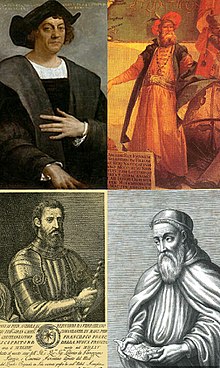
Italian[nb 1]explorersand navigators from the dominantmaritime republics,eager to find an alternative route to the Indies to bypass theOttoman Empire,played a key role in theAge of Discoveryand European colonization of the Americas. The most notable among them wereChristopher Columbus,who is credited with discovering the New World;[102]John Cabot,the first European to set foot in "New Found Land" and explore parts of the North American continent in 1497;[103]Amerigo Vespucci,who first demonstrated in about 1501 that the New World was not Asia as initially conjectured but a different continent (Americais named after him);[104]andGiovanni da Verrazzano,the first European to explore the Atlantic coast of North America between Florida and New Brunswick in 1524.[105]In the beginning of the 15th century, adventurers and traders such asNiccolò Da Contitravelled as far as Southeast Asia.
Warfare[edit]
In the 14th century, Northern Italy was divided into warring city-states, the most powerful beingMilan,Florence,Pisa,Siena,Genoa,Ferrara,Mantua,VeronaandVenice.High Medieval Northern Italy was further divided by the long-running battle for supremacy between the Papacy and theHoly Roman Empire.Warfare between the states was common, and invasion from outside Italy was confined to intermittent sorties ofHoly Roman Emperors.Since the 13th century, as armies became primarily composed ofmercenaries,prosperous city-states could field considerable forces despite their low populations. Over the 15th century, the most powerful city-states annexed their smaller neighbours: Florence tookPisain 1406, Venice capturedPaduaandVerona,while theDuchy of Milanannexed nearby areas includingPaviaandParma.
The early Renaissance saw almost constant warfare on land and sea as the city-states vied for preeminence. On land, these wars were primarily fought by armies of mercenaries known ascondottieri,bands of soldiers drawn from around Europe (especially Germany and Switzerland) led largely by Italian captains.[106]Decades of fighting saw Florence, Milan and Venice emerge as the dominant players. These three powers agreed to thePeace of Lodiin 1454, which saw relative calm brought to the region for the next forty years. At sea, the main contenders were Pisa, Genoa, and Venice, but after a long conflict, the Genoese succeeded in reducing Pisa. Venice proved to be a more powerful adversary, and with the decline of Genoese power during the 15th century Venice became pre-eminent on the seas.
Foreign invasions of Italy (theItalian Wars) began with the 1494 invasion by France that wreaked widespread devastation on Northern Italy and ended the independence of many of the city-states. Originally arising from dynastic disputes over the Duchy of Milan and the Kingdom of Naples, the wars rapidly became a general struggle for power and territory. The French were routed by Holy Roman EmperorCharles Vat theBattle of Pavia(1525) and again in theWar of the League of Cognac(1526–30). After years of inconclusive fighting and involvement by multiple countries, with thePeace of Cateau-Cambrésis(1559), France renounced its claims in Italy, while the south of Italy remained under Spanish rule.[107]
Much of Venice's hinterland (but not the city itself) wasdevastated by the Turksin 1499 and plundered by theLeague of Cambraiin 1509. Worst of all was the 6 May 1527Sack of Romeby mutinous German mercenaries that all but ended the role of the Papacy as the largest patron of Renaissance art. The longSiege of Florence (1529–1530)brought the destruction of its suburbs, the ruin of its export business and the confiscation of its citizens' wealth. Italy's urban population halved; ransoms paid to the invaders and emergency taxes drained the finances. The wool and silk industries of Lombardy collapsed when their looms were wrecked by invaders. The defensive tactic of scorched earth only slightly delayed the invaders, and made the recovery much longer.[108]
From the Counter-Reformation to Napoleon[edit]
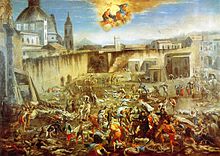
The 17th century was a tumultuous period in Italian history, marked by deep political and social changes. These included the increase of Papal power in the peninsula and the influence of the Catholic Church at the peak of theCounter Reformation,the Catholic reaction against the ProtestantReformation.From thePeace of Cateau-Cambrésisto thewar of the Spanish succession,the Spanish Habsburgs ruled Sicily, Naples, and Milan; these territories passed to theAustrian Habsburgsin 1700.
Despite important artistic and scientific achievements, such as the discoveries ofGalileoand the flourishing ofBaroquestyle, after 1600 Italy experienced an economic catastrophe. In 1600 Northern and Central Italy comprised one of the most advanced industrial areas of Europe, with an exceptionally high standard of living.[109]By 1870 Italy was an economically backward and depressed area; its industrial structure had almost collapsed, its population was too high for its resources, its economy had become primarily agricultural. Wars, political fractionalization, limited fiscal capacity and the shift of world trade to north-western Europe and the Americas were key factors.[110][111] The growing importance of the Atlantic trade undermined the importance of Venice as a commercial hub.[112]Spain's involvement in theThirty Years' War(1618–48), financed in part by taxes on its Italian possessions, heavily drained the commerce and agriculture of the south; as Spain declined, it dragged its Italian domains down with it, spreading conflicts and revolts (such as the Neapolitan 1647 tax-related "Revolt of Masaniello").[113] Theplague of 1630that ravagednorthern Italy,notably Milan and Venice, claimed possibly one million lives, or about 25% of the population.[114]The plague of 1656 killed up to 43% of the population of theKingdom of Naples.[115]Historians believe the dramatic reduction in population (and, thus, in economic activity) contributed to Italy's downfall as a major commercial and political centre.[116]By one estimate, while in 1500 the GDP of Italy was 106% of the French GDP, by 1700 it was only 75% of it.[117]
18th century[edit]
TheWar of the Spanish Succession(1701–1714) was triggered by the death without issue of the last Habsburg king of Spain,Charles II,who fixed the Spanish inheritance onPhilip, Duke of Anjou,the grandson of KingLouis XIVof France. In face of the threat of a French hegemony over much of Europe, aGrand Alliancebetween Austria, England, the Dutch Republic and other minor powers (including theDuchy of Savoy) was signed inThe Hague.The Alliance successfully fought and defeated the Franco-Spanish "Party of the Two Crowns", and the subsequentTreaty of UtrechtandRastattpassed control of much of Italy (Milan, Naples and Sardinia) from Spain to Austria, while Sicily was ceded to the Duchy of Savoy. Spain attempted to retake territories in Italy and to claim the French throne in theWar of the Quadruple Alliance(1718–1720), but was again defeated. As a result of theTreaty of The Hague,Spain agreed to abandon its Italian claims, while DukeVictor Amadeus II of Savoyagreed to exchange Sicily with Austria for the island of Sardinia, after which he was known as theKing of Sardinia.The Spaniards regained Naples and Sicily following theBattle of Bitontoin 1738.Corsicapassed from theRepublic of Genoato France in 1769 after theTreaty of Versailles.Italianwas the official language of Corsica until 1859.[118]
Age of Napoleon[edit]

At the end of the 18th century, Italy was almost in the same political conditions as in the 16th century; the main differences were thatAustriahad replaced Spain as the dominant foreign power (though theWar of the Polish Successionresulted in the re-installment of the Spanish in the south, as theHouse of Bourbon-Two Sicilies), and that the dukes ofSavoyhad become kings ofSardinia.In 1796 the FrenchArmy of ItalyunderNapoleoninvaded Italy, with the aims of forcing theFirst Coalitionto abandon Sardinia and forcing Austria to withdraw from Italy. Within only two weeksVictor Amadeus III of Sardiniawas forced to sign an armistice. Napoleon then entered Milan, where he was welcomed as a liberator. Subsequently, beating off Austrian counterattacks and continuing to advance, he arrived in theVenetoin 1797. Here occurred theVeronese Easters,an act of rebellion against French oppression, that tied down Napoleon for about a week.
Napoleon conquered most of Italy in 1797–99. He set up a series of new republics, complete with new codes of law and abolition of old feudal privileges. Napoleon'sCisalpine Republicwas centered on Milan. Genoa the city became a republic while its hinterland became theLigurian Republic.TheRoman Republicwas formed out of the papal holdings while the pope himself was sent to France. TheNeapolitan Republicwas formed around Naples, but it lasted only five months before the Coalition recaptured it. In 1805, he formed theKingdom of Italy,with himself as king and his stepson as viceroy. All these new countries were satellites of France, and had to pay large subsidies to Paris, as well as provide military support for Napoleon's wars. Their political and administrative systems were modernized, the metric system introduced, and trade barriers reduced. Jewish ghettos were abolished. Belgium and Piedmont became integral parts of France.[119]
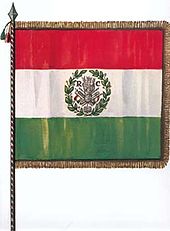
During the Napoleonic era,in 1797, the first official adoption of theItalian tricolouras a national flag by a sovereign Italian state, theCispadane Republic,asister republicofRevolutionary France,took place.[120][121]This event is celebrated by theTricolour Day.[122]TheItalian national coloursappeared for the first time ona tricolour cockadein 1789,[123]anticipating by seven years the first green, white and red Italian militarywar flag,which was adopted by theLombard Legionin 1796.[124]
In 1805, after the French victory over theThird Coalitionand thePeace of Pressburg,Napoleon recovered Veneto andDalmatia,anne xing them to the Italian Republic and renaming it theKingdom of Italy.Also that year a second satellite state, theLigurian Republic(successor to the oldRepublic of Genoa), was pressured into merging with France. In 1806, he conquered theKingdom of Naplesand granted it to his brother and then (from 1808) toJoachim Murat,along with marrying his sistersElisaandPaolinaoff to the princes ofMassa-CarraraandGuastalla.In 1808, he annexed Marche and Tuscany to the Kingdom of Italy. In 1809, Bonaparte occupied Rome,[125]exiling the Pope first to Savona and then to France.
After Russia, the other states of Europe re-allied themselves and defeated Napoleon at theBattle of Leipzig,after which his Italian allied states abandoned him to ally with Austria.[126]As Napoleon's reign began to fail, other national monarchs he had installed tried to keep their thrones by feeding nationalistic sentiments. Among these was the viceroy of Italy,Eugène de Beauharnais,who tried to get Austrian approval for his succession to the Kingdom of Italy, andJoachim Murat,who called for Italian patriots' help for the unification of Italy under his rule.[127]Napoleon was defeated on 6 April 1814. The resultingCongress of Vienna(1814) restored a situation close to that of 1795, dividing Italy between Austria (in the north-east and Lombardy), theKingdom of Sardinia,the Kingdom of theTwo Sicilies(in the south and in Sicily), andTuscany,thePapal Statesand other minor states in the centre. However, old republics such asVeniceandGenoawere not recreated, Venice went to Austria, and Genoa went to theKingdom of Sardinia.
On Napoleon's return to France (theHundred Days), he regained Murat's support, but Murat proved unable to convince the Italians to fight for Napoleon with hisProclamation of Riminiand was beaten and killed. The Italian kingdoms thus fell, and Italy's Restoration period began, with many pre-Napoleonic sovereigns returned to their thrones. Piedmont, Genoa and Nice came to be united, as did Sardinia (which went on to create the State of Savoy), while Lombardy, Veneto, Istria and Dalmatia were re-annexed to Austria. The dukedoms of Parma and Modena re-formed, and the Papal States and the Kingdom of Naples returned to the Bourbons. The political and social events in the restoration period of Italy (1815–1835) led to popular uprisings throughout the peninsula and greatly shaped what would become the Italian Wars of Independence. All this led to a newKingdom of ItalyandItalian unification.Frederick Artz emphasizes the benefits the Italians gained:
- For nearly two decades the Italians had the excellent codes of law, a fair system of taxation, a better economic situation, and more religious and intellectual toleration than they had known for centuries.... Everywhere old physical, economic, and intellectual barriers had been thrown down and the Italians had begun to be aware of a common nationality.[128]
Unification (1814–1861)[edit]
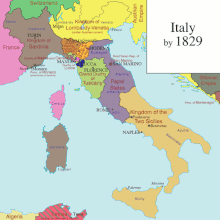
TheRisorgimentowas the political and social process that unified different states of theItalian Peninsula.It is difficult to pin down exact dates for the beginning and end of Italian reunification, but most scholars agree that it began with the end ofNapoleonicrule and theCongress of Viennain 1815, and approximately ended with theFranco-Prussian Warin 1871, though the last"città irredente"did not join until the Italian victory inWorld War I.
In 1820, Spaniards successfullyrevoltedover disputes about their Constitution, which influenced the development of a similar movement in Italy. A regiment in the army of theKingdom of Two Sicilies,commanded byGuglielmo Pepe,aCarbonaro(member of the secret republican organization),[129]mutinied, conquering the peninsular part of Two Sicilies. The king,Ferdinand I,agreed to enact a new constitution. The revolutionaries, though, failed to court popular support and fell to Austrian troops of theHoly Alliance.Ferdinand abolished the constitution and began systematically persecuting revolutionaries, many of whom were forced into exile.[130]
The leader of the 1821 revolutionary movement inPiedmontwasSantorre di Santarosa,who wanted to remove the Austrians and unify Italy under theHouse of Savoy.The Piedmont revolt started inAlessandria.The king's regent, princeCharles Albert,acting while the kingCharles Felixwas away, approved a newconstitutionto appease the revolutionaries, but when the king returned he disavowed the constitution and requested assistance from theHoly Alliance.Di Santarosa's troops were defeated, and the would-be Piedmontese revolutionary fled toParis.[133] Artistic and literary sentiment also turned towards nationalism; perhaps the most famous of proto-nationalist works wasAlessandro Manzoni'sI Promessi Sposi(The Betrothed),published in 1827. The 1840 version ofI Promessi Sposiused a standardized version of theTuscan dialect,a conscious effort by the author to provide a language and force people to learn it.
At the time, the struggle for Italian unification was perceived to be waged primarily against theAustrian Empireand theHabsburgs,since they directly controlled the predominantly Italian-speaking northeastern part of present-day Italy and were the single most powerful force against unification. The Austrian Empire vigorously repressed nationalist sentiment. Austrian Chancellor Franz Metternich, an influential diplomat at the Congress of Vienna, stated that the wordItalywas nothing more than "a geographic expression."[134]Those in favour of unification also faced opposition from theHoly See,particularly after failed attempts to broker a confederation with thePapal States,which would have left the Papacy with some measure of autonomy over the region.Pius IXfeared that giving up power in the region could mean the persecution of Italian Catholics.[135]
Even among those who wanted to see the peninsula unified, different groups could not agree on what form a unified state would take.Vincenzo Giobertisuggested a confederation of Italian states under the rulership of the Pope. His book,Of the Moral and Civil Primacy of the Italians,was published in 1843 and created a link between the Papacy and the Risorgimento. Many leading revolutionaries wanted a republic, but eventually, it was akingand hischief ministerwho had the power to unite the Italian states as a monarchy.

One of the most influential revolutionary groups was theCarbonari(charcoal burners), a secret organization formed in southern Italy early in the 19th century. Inspired by the principles of theFrench Revolution,its members were mainly drawn from the middle class and intellectuals. After the Congress of Vienna, theCarbonarimovement spread into the Papal States, theKingdom of Sardinia,theGrand Duchy of Tuscany,theDuchy of Modenaand theKingdom of Lombardy–Venetia.The revolutionaries were so feared that the reigning authorities passed an ordinance condemning to death anyone who attended a Carbonari meeting. TheCarbonaricondemnedNapoleon IIIto death for failing to unite Italy, and the group almost succeeded in assassinating him in 1858. Many leaders of the unification movement were at one time members of this organization. In this context, in 1847, the first public performance of the songIl Canto degli Italiani,the Italiannational anthemsince 1946, took place.[136][137] Two prominent radical figures in the unification movement wereGiuseppe MazziniandGiuseppe Garibaldi.The more conservative constitutional monarchic figures included theCount of CavourandVictor Emmanuel II,who would later become the firstking of a united Italy.Mazzini's activity in revolutionary movements caused him to be imprisoned soon after he joined. While in prison, he concluded that Italy could – and therefore should – be unified and formulated his program for establishing a free, independent, and republican nation with Rome as its capital. After Mazzini's release in 1831, he went toMarseille,where he organized a new political society calledLa Giovine Italia(Young Italy)seeking the unification of Italy. Garibaldi participated in an uprising inPiedmontin 1834, was sentenced to death, and escaped to South America. He returned to Italy in 1848. The creation of the Kingdom of Italy was the result of concerted efforts by Italian nationalists and monarchists loyal to theHouse of Savoyto establish a united kingdom encompassing the entireItalian Peninsula.
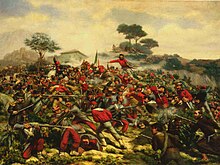
Sardinia industrialized from 1830 onward. A constitution, theStatuto Albertinowas enacted in the year of revolutions, 1848, under liberal pressure. Under the same pressure, theFirst Italian War of Independencewas declared on Austria. After initial success, the war took a turn for the worse and the Kingdom of Sardinia lost.
After theRevolutions of 1848,the apparent leader of the Italian unification movement was Garibaldi, popular amongst southern Italians.[138]Garibaldi led the Italian republican drive for unification in southern Italy, but the northern Italian monarchy of theHouse of Savoyin theKingdom of Piedmont-Sardiniawhose government was led byCamillo Benso, Count of Cavour,also had the ambition of establishing a united Italian state. Although the kingdom had no physical connection to Rome (deemed the natural capital of Italy), the kingdom had successfully challengedAustriain theSecond Italian War of Independence,liberatingLombardy–Venetiafrom Austrian rule. On the basis of thePlombières Agreement,the Kingdom of Sardinia cededSavoyandNiceto France, an event that caused theNiçard exodus,that was the emigration of a quarter of theNiçard Italiansto Italy.[139]The kingdom also had established important alliances which helped it improve the possibility of Italian unification, such asBritainand France in theCrimean War.
Garibaldi was elected in 1871 in Nice at theNational Assemblywhere he tried to promote the annexation of his hometown to the Italian unitary state, but he was prevented from speaking.[140]Because of this denial, between 1871 and 1872 there were riots in Nice, promoted by the Garibaldini and called "Niçard Vespers",[141]which demanded the annexation of the city and its area to Italy.[142]Fifteen Nice people who participated in the rebellion were tried and sentenced.[143]
Southern question and Italian diaspora[edit]
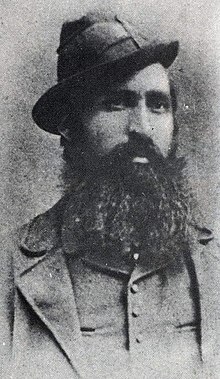
The transition was not smooth for the south (the "Mezzogiorno"). The path to unification and modernization created a divide between Northern and Southern Italy calledSouthern question.The entire region south of Naples was afflicted with numerous deep economic and social liabilities.[144]However, many of the South's political problems and its reputation of being "passive" or lazy (politically speaking) was due to the new government that alienated the South. On the other hand, transportation was difficult, soil fertility was low with extensive erosion, deforestation was severe, many businesses could stay open only because of high protective tariffs, large estates were often poorly managed, most peasants had only very small plots, and there was chronic unemployment and high crime rates.[145]
Cavour decided the basic problem was poor government, and believed that could be remedied by strict application of the Piedmontese legal system. The main result was an upsurge inbrigandage,which turned into a bloody civil war that lasted almost ten years. The insurrection reached its peak mainly inBasilicataand northernApulia,headed by the brigandsCarmine Croccoand Michele Caruso.[146]With the end of the southern riots, there was an outflow of millions of peasants in theItalian diaspora,especially to the United States and South America. Others relocated to the northern industrial cities such as Genoa, Milan and Turin, and sent money home.[145]
The first Italian diaspora began around 1880 and ended in the 1920s to the early 1940s with the rise ofFascist Italy.[147]Poverty was the main reason for emigration, specifically the lack of land asmezzadriasharecroppingflourished in Italy, especially in the South, and property became subdivided over generations. Especially inSouthern Italy,conditions were harsh.[147]Until the 1860s to 1950s, most of Italy was arural societywith many small towns and cities and almost no modern industry in which land management practices, especially in the South and theNortheast,did not easily convince farmers to stay on the land and to work the soil.[148]
Another factor was related to the overpopulation of Southern Italy as a result of the improvements in socioeconomic conditions afterUnification.[149]That created a demographic boom and forced the new generations to emigrate en masse in the late 19th century and the early 20th century, mostly to theAmericas.[150]The new migration of capital created millions of unskilled jobs around the world and was responsible for the simultaneous mass migration of Italians searching for "work and bread" (Italian:pane e lavoro).[151]
Unification broke down the feudal land system, which had survived in the south since the Middle Ages, especially where land had been the inalienable property of aristocrats, religious bodies or the king. The breakdown offeudalism,however, and redistribution of land did not necessarily lead to small farmers in the south winding up owning arable land. Many remained landless, and plots grew smaller and smaller and so less and less productive, as land was subdivided amongst heirs.[148]Between 1860 and World War I, at least 9 million Italians left permanently of a total of 16 million who emigrated, most travelling to North or South America.[152][150]
Liberal period (1861–1922)[edit]
Italy became a nation-stateon 17 March 1861, when most of the states of the peninsula were united under kingVictor Emmanuel II.The architects of Italian unification wereCamillo Benso, Count of Cavour,andGiuseppe Garibaldi.In 1866, Prussian Prime MinisterOtto von Bismarckoffered Victor Emmanuel II an alliance with theKingdom of Prussiain theAustro-Prussian War.In exchange Prussia would allow Italy to annex Austrian-controlledVenice.King Emmanuel agreed to the alliance and theThird Italian War of Independencebegan. The victory against Austria allowed Italy to annex Venice. In 1870, France started theFranco-Prussian Warand brought home its soldiers in Rome; Italy marched in to take over the Papal State. Italian unification was completed, and the capital was moved from Florence to Rome.[153]
Some of the states that had been targeted for unification (terre irredente),Trentino-Alto AdigeandJulian March,did not join the Kingdom of Italy until 1918 after Italy defeatedAustria-Hungaryin theFirst World War.For this reason, historians sometimes describe the unification period as reaching completion only with theArmistice of Villa Giustion 4 November 1918.[154][155]
Parliamentary democracy developed considerably in the 19th century. The SardinianStatuto Albertinoof 1848, extended to the wholeKingdom of Italyin 1861, provided for basic freedoms, but the electoral laws excluded the non-propertied and uneducated classes from voting. Italy's political arena was sharply divided between broad camps of left and right which created frequent deadlock and attempts to preserve governments.Marco Minghettilost power in 1876 and was replaced by theDemocratAgostino Depretis,who began a period of political dominance in the 1880s, but continued attempts to appease the opposition to hold power.
Depretis began his term by initiating an experimental political idea calledTrasformismo(transformism). The theory ofTrasformismowas that a cabinet should select a variety of moderates and capable politicians from a non-partisan perspective. In practice,trasformismowas authoritarian and corrupt: Depretis pressured districts to vote for his candidates if they wished to gain favourable concessions from Depretis when in power, resulting in only four representatives from the right being elected in 1876. Depretis put through authoritarian measures, such as banning public meetings, placing "dangerous" individuals in internal exile on remote penal islands, and adopting militarist policies. Depretis enacted controversial legislation for the time, such as abolishing arrest for debt, making elementary education free and compulsory while ending compulsory religious teaching in elementary schools.[156]The first government of Depretis collapsed after his dismissal of his Interior Minister, and ended with his resignation in 1877. The second government of Depretis started in 1881. Depretis' goals included widening suffrage in 1882 and increasing the tax intake from Italians by expanding the minimum requirements of who could pay taxes and the creation of a new electoral system.[157]In 1887, Depretis was finally pushed out of office after years of political decline.
Francesco Crispiwas Prime Minister from 1887 until 1891 and again from 1893 until 1896. Historian R.J.B. Bosworth says of his foreign policy that Crispi "pursued policies whose openly aggressive character would not be equaled until the days of the Fascist regime... His policies were ruinous, both for Italy's trade with France, and, more humiliatingly, for colonial ambitions in East Africa."[158]Crispi's major concerns during 1887–91 was protecting Italy from Austria-Hungary. Crispi worked to build Italy as a great world power through increased military expenditures, advocation of expansionism, and trying to win Germany's favor even by joining theTriple Alliance.While helping Italy develop strategically, he continuedtrasformismoand was authoritarian, once suggesting the use of martial law to ban opposition parties. Despite being authoritarian, Crispi put through liberal policies such as the Public Health Act of 1888 and establishing tribunals for redress against abuses by the government.[159]
The overwhelming attention paid to foreign policy alienated the agricultural community which needed help. Both radical and conservative forces in the Italian parliament demanded that the government investigate how to improve agriculture.[160]The investigation showed that agriculture was not improving, that landowners were swallowing up revenue from their lands and contributing almost nothing to development of the land. There was aggravation by lower class Italians to the break-up of communal lands which benefited only landlords. Most of the workers on the agricultural lands were not peasants but short-term labourers who at best were employed for one year. Peasants without stable income were forced to live off meager food supplies, disease was spreading rapidly, plagues were reported, including a majorcholeraepidemic which killed at least 55,000 people.[161]The Italian government could not deal with the situation effectively due to the mass overspending that left Italy in huge debt. Italy also suffered economically because of overproduction of grapes in the 1870s and 1880s when France's vineyard industry was suffering from vine disease. Italy during that time prospered as the largest exporter of wine in Europe but following the recovery of France in 1888, southern Italy was overproducing and had to split in two which caused greater unemployment and bankruptcies.[162]
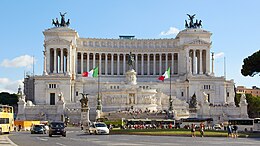
From 1901 to 1914, Italian history and politics was dominated byGiovanni Giolitti.He first confronted the wave of widespread discontent that Crispi's policy had provoked: no more authoritarian repression, but acceptance of protests and therefore of strikes, as long as they are neither violent nor political, with the (successful) aim of bringing the socialists in the political life of the country.[163][164]Giolitti's most important interventions were social and labor legislation, universal male suffrage, the nationalization of the railways and insurance companies, the reduction of state debt, and the development of infrastructure and industry. In foreign policy, there was a movement away from Germany and Austria-Hungary and toward theTriple Ententeof France, Britain and Russia.
Starting from the late 19th century, Italy developed its own colonial Empire. It took control ofSomalia.Its attempt to occupy Ethiopia failed in theFirst Italo–Ethiopian Warof 1895–1896. In 1911, Giolitti's government sent forces to occupy Libya and declared war on theOttoman Empire.Italy soon annexed Libya (then divided inTripolitaniaandCyrenaica) and theDodecanese Islandsafter theItalo-Turkish War.Nationalists advocated Italy's domination of the Mediterranean Sea by occupying Greece as well as the Adriatic coastal region ofDalmatiabut no attempts were made.[165]In June 1914 the left became repulsed by the government after the killing of three anti-militarist demonstrators. TheItalian Socialist Partydeclared a general strike in Italy. The protests that ensued became known as "Red Week",as leftists rioted and various acts of civil disobedience occurred such as seizing railway stations, cutting telephone wires and burning tax-registers.
World War I and failure of the liberal state[edit]

Italy entered into theFirst World Warin 1915 with the aim of completing national unity: for this reason, it is also considered theFourth Italian War of Independence,[166]in a historiographical perspective that identifies in the latter the conclusion of theunification of Italy.[167][168]
The war forced the decision whether to honor the alliance with Germany and Austria. For six months Italy remained neutral, as theTriple Alliancewas only for defensive purposes. Italy took the initiative in entering the war in spring 1915, despite strong popular and elite sentiment in favor of neutrality. Italy was a large, poor country whose political system was chaotic, its finances were heavily strained, and its army was very poorly prepared.[169]The Triple Alliance meant little either to Italians or Austrians. Prime MinisterAntonio Salandraand Foreign MinisterSidney Sonninonegotiated with both sides in secret for the best deal, and got one from the Entente, which was quite willing to promise large slices of the Austro-Hungarian Empire, including theTyrolandTrieste,as well as makingAlbaniaa protectorate. Russia vetoed giving ItalyDalmatia.Britain was willing to pay subsidies and loans to get 36 million Italians as new allies who threatened the southern flank of Austria.[170]

When theTreaty of Londonwas announced in May 1915, there was an uproar from antiwar elements. Reports from around Italy showed the people feared war, and cared little about territorial gains. Pro-war supporters mobbed the streets. The fervor for war represented a bitterly hostile reaction against politics as usual, and the failures, frustrations, and stupidities of the ruling class.[171][172]Benito Mussolinicreated the newspaperIl Popolo d'Italia,which at first attempted to convince socialists and revolutionaries to support the war.[173]TheAllied Powers,eager to draw Italy to the war, helped finance the newspaper.[174]Later, after the war, this publication would become the official newspaper of the Fascist movement.
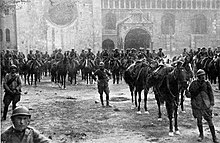
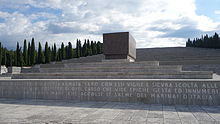
Italy entered the war with an army of 875,000 men, but the army was poorly led and lacked heavy artillery and machine guns, their war supplies having been largely depleted inthe war of 1911–12against Turkey. Italy proved unable to prosecute the war effectively, as fighting raged for three years on a very narrow front along theIsonzo River,where the Austrians held the high ground. In 1916, Italy declared war on Germany. Some 650,000 Italian soldiers died and 950,000 were wounded, while the economy required large-scale Allied funding to survive.[175][176]
Before the war the government had ignored labor issues, but now it had to intervene to mobilize war production. With the main working-class Socialist party reluctant to support the war effort, strikes were frequent and cooperation was minimal, especially in the Socialist strongholds of Piedmont and Lombardy. The government imposed high wage scales, as well as collective bargaining and insurance schemes.[177]Many large firms expanded dramatically. Inflation doubled the cost of living. Industrial wages kept pace but not wages for farm workers. Discontent was high in rural areas since so many men were taken for service, industrial jobs were unavailable, wages grew slowly and inflation was just as bad.[178]
The Italian victory,[179][180][181]which was announced by theBollettino della Vittoriaand theBollettino della Vittoria Navale,marked the end of the war on the Italian Front, secured the dissolution of theAustro-Hungarian Empireand was chiefly instrumental inendingthe First World War less than two weeks later. More than 651,000 Italian soldiers died on the battlefields.[182]The Italian civilian deaths were estimated at 589,000 due to malnutrition and food shortages.[183] As the war came to an end,Italian Prime MinisterVittorio Emanuele Orlandomet withBritish Prime MinisterDavid Lloyd George,Prime Minister of FranceGeorges ClemenceauandUnited States PresidentWoodrow WilsoninVersaillesto discuss how the borders of Europe should be redefined to help avoid a future European war. The talks provided little territorial gain to Italy as Wilson promised freedom to all European nationalities to form their nation-states. As a result, theTreaty of Versaillesdid not assignDalmatiaandAlbaniato Italy as had been promised. Furthermore, the British and French decided to divide the German overseas colonies into their mandates, with Italy receiving none. Italy also gained no territory from the breakup of theOttoman Empire.Despite this, Orlando agreed to sign the Treaty of Versailles, which caused uproar against his government. TheTreaty of Saint-Germain-en-Laye(1919) and theTreaty of Rapallo(1920) allowed the annexation ofTrentino Alto-Adige,Julian March,Istria,Kvarneras well as theDalmatiancity ofZara.
Furious over the peace settlement, the Italian nationalist poetGabriele D'Annunzioled disaffected war veterans and nationalists to form theFree State of Fiumein September 1919. His popularity among nationalists led him to be calledIl Duce( "The Leader" ), and he used black-shirted paramilitary in his assault on Fiume. The leadership title ofDuceand the blackshirt paramilitary uniform would later be adopted by thefascistmovement ofBenito Mussolini.The demand for the Italian annexation of Fiume spread to all sides of the political spectrum.[184]
The subsequentTreaty of Rome(1924) led to the annexation of the city ofFiumeto Italy. Italy's lack of territorial gain led to the outcome being denounced as amutilated victory.The rhetoric ofmutilated victorywas adopted by Mussolini and led to therise ofItalian fascism,becoming a key point in thepropaganda of Fascist Italy.Historians regardmutilated victoryas a "political myth", used by fascists to fuelItalian imperialismand obscure the successes ofliberal Italyin the aftermath of World War I.[185]Italy also gained a permanent seat in theLeague of Nations's executive council.
Fascist regime, World War II, and Civil War (1922–1946)[edit]
Rise of Fascism into power[edit]
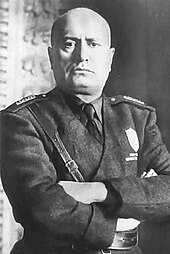
Benito Mussolinicreated theFasci di Combattimentoor Combat League in 1919. It was originally dominated by patriotic socialist andsyndicalistveterans who opposed the pacifist policies of the Italian Socialist Party. This early Fascist movement had a platform more inclined to the left, promising social revolution, proportional representation in elections, women's suffrage (partly realized in 1925) and dividing rural private property held by estates.[186][187]They also differed from later Fascism by opposingcensorship,militarismanddictatorship.[188]
At the same time, the so-calledBiennio Rosso(red biennium) took place in the two years following the war in a context of economic crisis, high unemployment and political instability. The 1919–20 period was characterized by mass strikes, worker manifestations as well as self-management experiments through land and factory occupations. InTurinandMilan,workers councilswere formed and manyfactory occupationstook place under the leadership ofanarcho-syndicalists.The agitations also extended to the agricultural areas of thePadan plainand were accompanied by peasant strikes, rural unrests and guerilla conflicts between left-wing and right-wing militias. Thenceforth, the Fasci di Combattimento (forerunner of theNational Fascist Party,1921) successfully exploited the claims of Italian nationalists and the quest for order and normalization of the middle class. In October 1922, Mussolini took advantage of a general strike to announce his demands to the Italian government to give the Fascist Party political power or face a coup. With no immediate response, a group of 30,000 Fascists began a long trek across Italy to Rome (theMarch on Rome), claiming that Fascists were intending to restore law and order. The Fascists demanded Prime MinisterLuigi Facta's resignation and that Mussolini be named to the post. Although the Italian Army was far better armed than the Fascist militias, the liberal system and KingVictor Emmanuel IIIwere facing a deeper political crisis. The King was forced to choose which of the two rival movements in Italy would form the government: Mussolini's Fascists, or the marxistItalian Socialist Party.He selected the Fascists.
Mussolini formed a coalition with nationalists and liberals, and in 1923 passed the electoralAcerbo Law,which assigned two thirds of the seats to the party that achieved at least 25% of the vote. The Fascist Party used violence and intimidation to achieve the threshold in the1924 election,thus obtaining control of Parliament. Socialist deputyGiacomo Matteottiwas assassinated after calling for a nullification of the vote. The parliament opposition responded to Matteotti's assassination with theAventine Secession.
Over the next four years, Mussolini eliminated nearly all checks and balances on his power. On 24 December 1925, he passed a law that declared he was responsible to the king alone, making him the sole person able to determine Parliament's agenda. Local governments were dissolved, and appointed officials (called "Podestà" ) replaced elected mayors and councils. In 1928, all political parties were banned, and parliamentary elections were replaced by plebiscites in which the Grand Council of Fascism nominated a single list of 400 candidates.Christopher Dugganargues that his regime exploited Mussolini's popular appeal and forged a cult of personality that served as the model that was emulated by dictators of other fascist regimes of the 1930s.[189]
In summary, historianStanley G. Paynesays that Fascism in Italy was:
- A primarily political dictatorship. The Fascist Party itself had become almost completely bureaucratized and subservient to, not dominant over, the state itself. Big business, industry, and finance retained extensive autonomy, particularly in the early years. The armed forces also enjoyed considerable autonomy.... The Fascist militia was placed under military control. The judicial system was left largely intact and relatively autonomous as well. The police continued to be directed by state officials and were not taken over by party leaders, nor was a major new police elite created. There was never any question of bringing the Church under overall subservience. Sizable sectors of Italian cultural life retained extensive autonomy, and no major state propaganda-and-culture ministry existed. The Mussolini regime was neither especially sanguinary nor particularly repressive.[190]
End of the Roman question[edit]
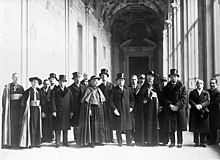
During theunification of Italyin the mid-19th century, thePapal Statesresisted incorporation into the new nation. The nascent Kingdom of Italy invaded and occupiedRomagna(the eastern portion of the Papal States) in 1860, leaving onlyLatiumin the pope's domains. Latium, including Rome itself, wasoccupiedand annexed in 1870. For the following sixty years, relations between the Papacy and the Italian government were hostile, and the status of the pope became known as the "Roman Question".
TheLateran Treatywas one component of the Lateran Pacts of 1929, agreements between the Kingdom of Italy under KingVictor Emmanuel III of Italyand theHoly SeeunderPope Pius XIto settle the question. The treaty and associated pacts were signed on 11 February 1929.[191]The treaty recognizedVatican Cityas anindependent stateunder the sovereignty of the Holy See. The Italian government also agreed to give the RomanCatholic Churchfinancial compensation for the loss of thePapal States.[192]In 1948, the Lateran Treaty was recognized in theConstitution of Italyas regulating the relations between the state and the Catholic Church.[193]The treaty was significantly revised in 1984, ending the status of Catholicism as the sole state religion.
Foreign politics[edit]
Lee identifies three major themes in Mussolini's foreign policy. The first was a continuation of the foreign-policy objectives of the preceding Liberal regime. Liberal Italy had allied itself with Germany and Austria, and had great ambitions in the Balkans and North Africa. Ever since it had been badly defeated in Ethiopia in 1896, there was a strong demand for seizing that country. Second was a profound disillusionment after the heavy losses of the First World War; the small territorial gains from Austria were not enough to compensate. Third was Mussolini's promise to restore the pride and glory of theRoman Empire.[194]
Italian Fascism is based uponItalian nationalismand in particular, seeks to complete what it considers as the incomplete project ofRisorgimentoby incorporatingItalia Irredenta(unredeemed Italy) into the state of Italy.[195][196]To the east of Italy, the Fascists claimed thatDalmatiawas a land of Italian culture.[197]To the south, the Fascists claimedMalta,which belonged to the United Kingdom, andCorfu,which belonged to Greece, to the north claimedItalian Switzerland,while to the west claimedCorsica,NiceandSavoy,which belonged to France.[198][199]
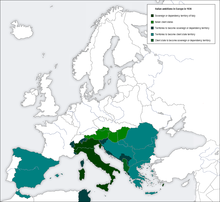
Legend:
Mussolini promised to bring Italy back as agreat powerin Europe, building a "New Roman Empire" and holding power over theMediterranean Sea.Inpropaganda,Fascists used the ancient Roman motto "Mare Nostrum"(Latinfor "Our Sea" ) to describe the Mediterranean. For this reason the Fascist regime engaged ininterventionist foreign policyin Europe. In 1923, the Greek island ofCorfuwas briefly occupied by Italy, after the assassination ofGeneral Telliniin Greek territory. In 1925,Albaniacame under heavy Italian influence as a result of theTirana Treaties,which also gave Italy a stronger position in the Balkans.[200]Relations with France were mixed. The Fascist regime planned to regain Italian-populated areas of France.[201]With the rise of Nazism, it became more concerned about the potential threat of Germany to Italy. Due to concerns about German expansionism, Italy joined theStresa Frontwith France and the United Kingdom, which existed from 1935 to 1936. The Fascist regime held negative relations with Yugoslavia, as it continued to claim Dalmatia.
During theSpanish Civil Warbetween the socialistRepublicansandNationalistsled byFrancisco Franco,Italy sent arms and over 60,000 troops to aid the Nationalist faction. This secured Italy's naval access to Spanish ports and increased Italian influence in the Mediterranean. During the 1930s, Italy strongly pursued a policy of naval rearmament; by 1940, theRegia Marinawas the fourth-largest navy in the world.
Mussolini andAdolf Hitlerfirst met in June 1934, when Mussolini opposed German plans to annex Austria to ensure that Nazi Germany would not become hegemonic in Europe. Public appearances and propaganda constantly portrayed the closeness of Mussolini and Hitler and the similarities between Italian Fascism and GermanNational Socialism.While both ideologies had significant similarities, the two factions were suspicious of each other, and both leaders were in competition for world influence.
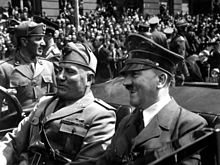
In 1935 Mussolini decided to invadeEthiopia;2,313 Italians and 275,000 Ethiopians died.[202]TheSecond Italo-Ethiopian Warresulted in the international isolation of Italy; the only nation to back Italy's aggression was Germany. After being condemned by theLeague of Nations,Italy decided to leave the League on 11 December 1937.[203]Mussolini had little choice but to join Hitler in international politics, thus he reluctantly abandoned support of Austrian independence. Mussolini later supported German claims onSudetenlandat theMunich Conference.In 1938, under the influence of Hitler, Mussolini supported the adoption of anti-semiticracial lawsin Italy. After Germany annexedCzechoslovakiain March 1939,Italy invaded Albaniaand made it anItalian protectorate.
As war approached in 1939, the Fascist regime stepped up an aggressive press campaign against France claiming that its Italian residents were suffering.[204]This was important to the alliance as both regimes mutually had claims on France: Germany on German-populatedAlsace-Lorraineand Italy on the mixed Italian and French populatedNiceandCorsica.In May 1939, a formal alliance with Germany was signed, known as thePact of Steel.Mussolini felt obliged to sign the pact in spite of his own concerns that Italy could not fight a war in the near future. This obligation grew from his promises to Italians that he would build an empire for them and from his personal desire to not allow Hitler to become the dominant leader in Europe.[205]Mussolini was repulsed by theMolotov–Ribbentrop Pactagreement where Germany and theSoviet Unionagreed to partition theSecond Polish Republicinto German and Soviet zones for an impending invasion. The Fascist government saw this as a betrayal of theAnti-Comintern Pact,but decided to remain officially silent.[205]
World War II and fall of Fascism[edit]
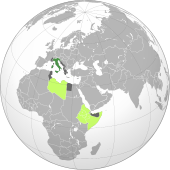
When Germanyinvaded Polandon 1 September 1939 beginningWorld War II,Mussolini chose to staynon-belligerent,although he declared his support for Hitler. In drawing out war plans, Mussolini and the Fascist regime decided that Italy would aim to annex large portions of Africa and the Middle East. Hesitance remained from the King and military commanderPietro Badogliowho warned Mussolini that Italy had too fewtanks,armoured vehicles,and aircraft available to be able to carry out a long-term war.[206]Mussolini and the Fascist regime thus waited as France was invaded by Germany in June 1940 (Battle of France) before deciding to get involved.
Italy entered the war on 10 June 1940, fulfilling its obligations towards the Pact of Steel. Mussolini hoped to quickly captureSavoy,Nice, Corsica, and the African colonies of Tunisia and Algeria from the French, but Germany signed an armistice (22 June:Second Armistice at Compiègne) with MarshalPhilippe PétainestablishingVichy France,that retained control over southern France and colonies. This decision angered the Fascist regime.[207]In summer 1940, Mussolini ordered thebombing of Mandatory Palestineand theconquest of British Somaliland.In September, he ordered theinvasion of Egypt;despite initial success, Italian forces were soon driven back by the British (seeOperation Compass). Hitler had to intervene with the sending of theAfrika Korpsthat was the mainstay in theNorth African campaign.
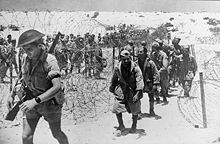
On 28 October, Mussolini launchedan attackon Greece. TheRoyal Air Forceprevented the Italian invasion and allowed the Greeks to push the Italians back to Albania. Hitler came to Mussolini's aid by attacking the Greeks through the Balkans. TheBalkans Campaignhad as a result the dissolution of Yugoslavia and Greece's defeat. Italy gainedsouthern Slovenia,Dalmatia,Montenegroand established the puppet states ofCroatiaandHellenic State.By 1942, it was faltering as its economy failed to adapt to the conditions of war and Italian cities were being heavily bombed by the Allies. Also, despite Rommel's advances, the campaign in North Africa began to fail in late 1942. The complete collapse came after the decisive defeat atEl Alamein.
By 1943, Italy was losing on every front. Half of the Italian forcesfighting in the Soviet Unionhad been destroyed,[208]the African campaign had failed, the Balkans remained unstable, and Italians wanted an end to the war.[209]In July 1943, theAlliesinvaded Sicilyin an effort to knock Italy out of the war and establish a foothold in Europe. On 25 July,Mussolini was oustedby theGreat Council of Fascismand arrested by order of King Victor Emmanuel III, who appointed GeneralPietro Badoglioas newPrime Minister.Badoglio stripped away the final elements of Fascist rule by banning theNational Fascist Party,then signed anarmistice with the Allied armed forces.
Donald Detwiler notes that "Italy's entrance into the war showed very early that her military strength was only a hollow shell."[210]Historians have long debated why Italy's military and its Fascist regime were so remarkably ineffective at war, which was central to their identity. MacGregor Knox says the explanation, "was first and foremost a failure of Italy's military culture and military institutions."[211]Norman Polmar and Thomas B. Allen argue that "the Regia Aeronautica failed to perform effectively in modern conflict."[212]James Sadkovich gives the most charitable interpretation of Italian failures, blaming inferior equipment, overextension, and inter-service rivalries. Its forces had "more than their share of handicaps."[213]
Civil War, Allied advance, and Liberation[edit]
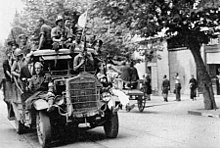
Soon after being ousted, Mussolini was rescued by a German commando inOperation Eiche( "Oak" ). The Germans brought Mussolini to northern Italy where he set up a Fascist puppet state, theItalian Social Republic(RSI). Meanwhile, the Allies advanced in southern Italy. In September 1943,Naplesrose against the occupying German forces. The Allies organized some royalist Italian troops into theItalian Co-Belligerent Army,while other troops continued to fight alongside Nazi Germany in theEsercito Nazionale Repubblicano,theNational Republican Army.A largeItalian resistance movementstarted a longguerrilla waragainst the German and Fascist forces,[214]while clashes between the Fascist RSI Army and the Royalist Italian Co-Belligerent Army were rare.[215]The Germans, often helped by Fascists, committed severalatrocitiesagainst Italian civilians in occupied zones, such as theArdeatine massacreand theSant'Anna di Stazzema massacre.The Kingdom of Italy declared war on Nazi Germany on 13 October 1943;[216][217]tensions between the Axis Powers and the Italian military were rising following the failure to defend Sicily.[216]
On 4 June 1944, the German occupation of Rome came to an end as the Allies advanced. The final Allied victory over the Axis in Italy did not come until the spring offensive of 1945, after Allied troops had breached theGothic Line,leading to the surrender of German and Fascist forces in Italy on 2 May shortly before Germany finally surrendered ending World War II in Europe on 8 May. It is estimated that between September 1943 and April 1945, some 60,000 Allied and 50,000 German soldiers died in Italy.[nb 2]
During World War II,Italian war crimesincludedextrajudicial killingsandethnic cleansing[219]by the deportation of about 25,000 people, mainly Jews, Croats, and Slovenians, to theItalian concentration camps,such asRab,Gonars,Monigo,Renicci di Anghiariand elsewhere.Yugoslav Partisansperpetrated their own crimes against the local ethnic Italian population during and after the war, including thefoibe massacres.In Italy and Yugoslavia, unlike in Germany, few war crimes were prosecuted.[220][221][222][223]
On 25 April 1945 theNational Liberation Committee for Northern Italyproclaimed a general insurrection in all the territories still occupied by the Nazis, indicating to all the partisan forces active in Northern Italy that were part of the Volunteer Corps of Freedom to attack the fascist and German garrisons by imposing the surrender, days before the arrival of the Allied troops; at the same time, the National Liberation Committee for Northern Italy personally issued legislative decrees,[224]assuming power "in the name of the Italian people and as a delegate of the Italian Government", establishing among other things the death sentence for all fascist hierarchs,[225]Today the event is commemorated in Italy every 25 April by theLiberation Day,National Dayintroduced on 22 April 1946, which celebrates the liberation of the country fromfascism.[226]
Mussolini was captured on 27 April 1945 and the next day was executed for high treason. On 2 May 1945, the German forces in Italy surrendered. On 9 June 1944, Badoglio was replaced as Prime Minister by anti-fascist leaderIvanoe Bonomi.In June 1945 Bonomi was in turn replaced byFerruccio Parri,who in turn gave way toAlcide de Gasperion 4 December 1945. Finally, De Gasperi supervised the transition to a Republic following the abdication of Vittorio Emanuele III on 9 May 1946, the one-month-long reign of his sonUmberto II( "King of May" ) and theConstitutional Referendumthat abolished the monarchy; De Gasperi briefly became acting Head of State as well as Prime Minister on 18 June 1946, but ceded the former role to Provisional PresidentEnrico de Nicolaten days later.
Anti-fascism against Mussolini's regime[edit]
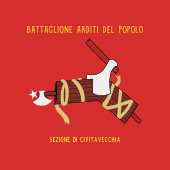
In Italy, Mussolini'sfascistregime used the termanti-fascistto describe its opponents. Mussolini'ssecret policewas officially known as theOrganization for Vigilance and Repression of Anti-Fascism(OVRA). During the 1920s, anti-fascists, many of them from thelabour movement,fought against the violentBlackshirtsand against the rise of the fascist leader Benito Mussolini. After theItalian Socialist Party(PSI) signed apacification pactwith Mussolini and hisFasces of Combaton 3 August 1921,[227]and trade unions adopted a legalist and pacified strategy, members of the workers' movement who disagreed with this strategy formedArditi del Popolo.[228]
TheItalian General Confederation of Labour(CGL) and the PSI refused to officially recognize the anti-fascist militia and maintained a non-violent, legalist strategy, while theCommunist Party of Italy(PCd'I) ordered its members to quit the organization. The PCd'I organized some militant groups, but their actions were relatively minor.[229]The Italian anarchistSeverino Di Giovanni,who exiled himself to Argentina following the 1922March on Rome,organized several bombings against the Italian fascist community.[230]The Italian liberal anti-fascistBenedetto Crocewrote hisManifesto of the Anti-Fascist Intellectuals,which was published in 1925.[231]Other notable Italian liberal anti-fascists around that time werePiero GobettiandCarlo Rosselli.[232]
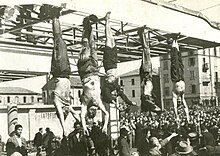
Concentrazione Antifascista Italiana(English:Italian Anti-Fascist Concentration), officially known as Concentrazione d'Azione Antifascista (Anti-Fascist Action Concentration), was an Italian coalition of Anti-Fascist groups which existed from 1927 to 1934, trying to promote and to coordinate expatriate actions to fight fascism in Italy; they published a propaganda paper entitledLa Libertà.[233][234][235]Giustizia e Libertà(English:Justice and Freedom) was an Italiananti-fascistresistance movement,active from 1929 to 1945[236]which shared a belief in active, effective opposition to fascism, compared to the older Italian anti-fascist parties.Giustizia e Libertàalso made the international community aware of the realities of fascism in Italy, thanks to the work ofGaetano Salvemini.
Between 1920 and 1943, several anti-fascist movements were active among theSlovenesandCroatsin the territories annexed to Italy afterWorld War I,known as theJulian March.[237][238]The most influential was the militant insurgent organizationTIGR,which carried out numerous sabotages, as well as attacks on representatives of the Fascist Party and the military.[239][240]Most of the underground structure of the organization was discovered and dismantled by the OVRA in 1940 and 1941,[241]and after June 1941 most of its former activists joined theSlovene Partisans.Many members of theItalian resistanceleft their homes and went to live in the mountains, fighting against Italian fascists andGerman Nazisoldiers during theItalian Civil War.Many cities in Italy, includingTurin,NaplesandMilan,were freed by anti-fascist uprisings.[242]
Republican era (1946–present)[edit]
Birth of the Republic[edit]

The aftermath of World War II left Italy with a destroyed economy, a divided society, and anger against the monarchy for its endorsement of the Fascist regime. These frustrations contributed to a revival of the Italian republican movement.[243]Umberto IIwas pressured by the threat of another civil war to call the1946 Italian institutional referendumto decide whether Italy should remain a monarchy or become a republic. On 2 June 1946, the republican side won 54% of the vote and Italy officially became a republic.
Under theTreaty of Peace with Italy, 1947,Istria,Kvarner,most of theJulian Marchas well as theDalmatiancity ofZarawas annexed byYugoslaviacausing theIstrian-Dalmatian exodus,which led to the emigration of between 230,000 and 350,000 local ethnicItalians(Istrian ItaliansandDalmatian Italians), the others being ethnic Slovenians, ethnic Croatians, and ethnicIstro-Romanians,choosing to maintain Italian citizenship.[244]Later, theFree Territory of Triestewas divided between the two states. Italy also lost all of its colonial possessions, formally ending theItalian Empire.In 1950,Italian Somalilandwas made aUnited Nations Trust Territoryunder Italian administration until 1 July 1960. The Italian border that applies today has existed since 1975, whenTriestewas formally re-annexed to Italy.
TheGeneral Elections of 1946,held at the same time as the Constitutional Referendum, elected 556 members of aConstituent Assembly.Anew constitutionwas approved, setting up aparliamentarydemocracy. In 1947, under American pressure, the communists were expelled from the government. TheItalian general election, 1948saw a landslide victory for Christian Democrats, that dominated the system for the following forty years.
Italy joined theMarshall Plan(ERP) andNATO.By 1950, the economy had largely stabilized and started booming.[245]In 1957, Italy was a founding member of theEuropean Economic Community,which later transformed into the European Union (EU). The Marshall Plan's long-term legacy was to help modernize Italy's economy.[246]By 1953, industrial production had doubled compared with 1938 and the annual rate of productivity increase was 6.4%, twice the British rate.
Economic miracle[edit]
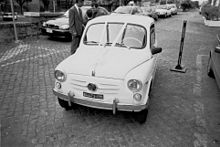
In the 1950s and 1960s, the country enjoyed a prolonged economic boom, which was accompanied by a dramatic rise in the standard of living of ordinary Italians.[247]The so-calledItalian economic miraclelasted almost uninterruptedly until the "Hot Autumn's "massive strikes and social unrest of 1969–70, that combined with the later1973 oil crisis,gradually cooled the economy. It has been calculated that the Italian economy experienced an average rate of growth of GDP of 5.8% per year between 1951 and 1963, and 5.0% per year between 1964 and 1973.[248]Between 1955 and 1971, around 9 million people are estimated to have been involved in inter-regional migrations in Italy, uprooting entire communities.[249]Emigration was especially directed to the factories of the so-called "industrial triangle", a region encompassed between the major manufacturing centres ofMilanandTurinand the seaport ofGenoa.
The needs of a modernizing economy demanded new transport and energy infrastructures. Thousands of kilometres of railways and highways were completed in record times to connect the main urban areas, while dams and power plants were built all over Italy, often without regard for geological and environmental conditions. Strong urban growth led to uncontrolled urban sprawl. The natural environment was constantly under threat by wild industrial expansion, leading to ecological disasters like theVajont Daminundation and theSevesochemical accident.
Years of Lead[edit]

During the 1970s, Italy saw an unexpected escalation of political violence. From 1969 to 1980, repeated neofascist outrages were launched such as thePiazza Fontana bombingin 1969. Red Brigades and many other groups decided on armed attacks as a revolutionary strategy. They carried out urban riots, as in Rome and Bologna in 1977. Known as theYears of Lead,this period was characterised by widespread social conflicts and terrorist acts carried out by extra-parliamentary movements. The assassination of the leader of theChristian Democracy(DC),Aldo Moro,led to the end of a "historic compromise"between the DC and theCommunist Party(PCI). In the 1980s, for the first time, two governments were managed by a Republican (Giovanni Spadolini1981–82) and a Socialist (Bettino Craxi1983–87) rather than by a Christian Democrat.[250][251]
At the end of the Lead years, the PCI gradually increased their votes thanks toEnrico Berlinguer.TheSocialist Party(PSI), led byBettino Craxi,became more and more critical of the Communists and of theSoviet Union;Craxi himself pushed in favour of US PresidentRonald Reagan's positioning ofPershing IImissiles in Italy.
Second Republic (1992–present)[edit]
Italy faced several terror attacks between 1992 and 1993, perpetrated by theSicilian Mafiaas a consequence of several life sentences pronounced during the "Maxi Trial",and of the new anti-mafia measures launched by the government. In 1992, two major dynamite attacks killed two judges,[252]and a year later tourist spots, leaving 10 dead and 93 injured and causing severe damage to cultural heritage such as theUffizi Gallery.The Catholic Church openly condemned the Mafia, and two churches were bombed and an anti-Mafia priest shot dead in Rome.[253][254]
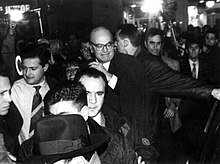
From 1992 to 1997, Italy faced significant challenges as voters disenchanted with political paralysis, massive government debt, extensive corruption, and organised crime's considerable influence collectively called the political systemTangentopoli.As Tangentopoli was under a set of judicial investigations by the name ofMani pulite(Italian for "clean hands" ), voters demanded political, economic, and ethical reforms. Between 1992 and 1994 theDCunderwent a severe crisis and was dissolved, splitting up into several pieces. ThePSI(along with other minor governing parties) completely dissolved.[255][256]
The1994 general electionalso swept media magnateSilvio Berlusconi(Leader of "Pole of Freedoms"coalition) into office as Prime Minister. Berlusconi was forced to step down in December 1994 when hisLega Nordpartners withdrew support. The Berlusconi government was succeeded by atechnical governmentheaded byLamberto Dini.At the1996 general election,Romano Prodiled a centre-left coalition to victory. He narrowly lost a vote of confidence in October 1998. A new government was formed byDemocrats of the LeftleaderMassimo D'Alema,but in April 2000, following poor performance by his coalition in regional elections, he resigned.
The succeeding centre-left government was headed byGiuliano Amato(social-democratic), who previously served as Prime Minister from 1992 to 1993 and again from April 2000 until June 2001. That same year, a centre-right coalitionformed the governmentandSilvio Berlusconiwas able to regain power and keep it for a complete five-year mandate, becoming the longest-serving government in post-war Italy. Berlusconi participated in the US-ledmultinational coalition in Iraq.
The2006 general electionreturned Prodi to government, leading a coalition of 11 parties (The Union). Prodi followed a cautious policy of economic liberalisation and reduction of public debt. Berlusconi won the2008 general election.Italy was among the countries hit hardest by theGreat Recessionof 2008–09 and the subsequentEuropean debt crisis.The national economy shrunk by 6.76% over seven quarters of recession.[257]In November 2011, the Italian bond yield was 6.74 per cent for 10-year bonds, nearing a 7% level where Italy is thought to lose access to financial markets.[258]On 12 November 2011, Berlusconi resigned, and the economistMario Montiwas sworn in as Prime Minister at the head of atechnocraticgovernment. To avoid the debt crisis and kick-start economic growth, Monti'snational unity governmentlaunched a massive programme ofausterity measures;that reduced the deficit but precipitated adouble-dip recessionin 2012 and 2013.[259][260]
On 24 and 25 February 2013, ageneral electionwas held; a centre-left coalition ledPier Luigi Bersani,Leader of theDemocratic Party,won a slight majority in the Chamber of Deputies but did not control the Senate. On 24 April, President Napolitano gave to the Vice-Secretary of the Democratic Party,Enrico Letta,the task of forming a government. Letta formed a short-livedgrand coalitiongovernment which lasted until 22 February 2014.Matteo Renziformed a newgovernmentwith the support of some centrist parties. The government implemented numerous reforms, including changes to theelectoral system,a relaxation of labour and employment laws with the intention of boosting economic growth, a thorough reformation of thepublic administrationand the introduction ofsame-sex civil unions.[261]However, Renzi resigned after losing aconstitutional referendumin December 2016, and was succeeded byPaolo Gentiloni.The centre-left Cabinets were plagued by the aftermath of theEuropean debt crisisand theEuropean migrant crisis,which fuelled support for populist and right-wing parties.[262]

The2018 general electionresulted in ahung parliamentonce again, which led to an unlikelypopulist governmentled byGiuseppe Conte.[263]However, after only fourteen months, the League withdrew its support and Conte allied with the Democratic Party and other smaller left-wing parties to form a new Cabinet.[264][265]In 2020, Italy was severely hit by theCOVID-19 pandemic.[266]From March to May 2020, Conte's government imposed anational lockdownto limit the spread.[267][268]The measures, despite being widely approved by public opinion,[269]were also described as the largest suppression ofconstitutional rightsin the history of the republic.[270][271]With more than 100,000 confirmed fatalities, Italy had one of the highest total number of deaths in thecoronavirus pandemic.[272]The pandemic caused also asevere economic disruption.[273]In February 2021, these extraordinary circumstances resulted in the formation of anational coalition governmentled by former President of the European Central BankMario Draghi.[274]In January 2022, PresidentSergio Mattarellawas re-elected.[275]
On 21 July 2022, following agovernment crisis,Draghi resigned.[276]Asnap electionresulted in thecentre-right coalitiongaining an absolute majority.[277]On 22 October 2022,Giorgia Meloniwas sworn in as Italy's first female prime minister.[278]
See also[edit]
- Duchy of Urbino
- Genetic history of Italy
- History of Capri
- History of Naples
- History of Rome
- History of Sardinia
- History of Sicily
- History of the Republic of Venice
- History of Trentino
- History of Tuscany
- History of Verona
- Kingdom of Lombardy–Venetia
- List of consorts of Montferrat
- List of consorts of Naples
- List of consorts of Savoy
- List of consorts of the Kingdom of the Two Sicilies
- List of consorts of Tuscany
- List of Italian queens
- List of Italian inventions and discoveries
- List of kings of the Lombards
- List of Milanese consorts
- List of Modenese consorts
- List of monarchs of Naples
- List of monarchs of Sardinia
- List of monarchs of Sicily
- List of monarchs of the Kingdom of the Two Sicilies
- List of Parmese consorts
- List of presidents of Italy
- List of prime ministers of Italy
- List of queens of the Lombards
- List of Roman and Byzantine Empresses
- List of grand dukes of Tuscany
- List of Sardinian consorts
- List of Sicilian consorts
- List of State Archives of Italy
- List of viceroys of Naples
- List of viceroys of Sicily
- Milan
- Military history of Italy
- Politics of Italy
Notes[edit]
- ^Though the modern state of Italy had yet to be established, the Latin equivalent of theterm Italianhad been in use for natives ofthe regionsince antiquity. SeePliny the Elder,Letters9.23.
- ^InAlexander's GeneralsBlaxland quotes 59,151 Allied deaths between 3 September 1943 and 2 May 1945 as recorded at AFHQ and gives the breakdown between 20 nationalities: United States 20,442; United Kingdom, 18,737; France, Morocco, Algeria, Tunisia, Senegal and Belgium 5,241; Canada, 4,798; India, Pakistan, Nepal 4,078; Poland 2,028; New Zealand 1,688; Italy (excluding irregulars) 917; South Africa 800; Brazil 275; Greece 115;Jewish volunteersfrom theBritish Mandate in Palestine32. In addition, 35 soldiers were killed by enemy action while serving with pioneer units from Botswana, Lesotho, Swaziland, Seychelles, Mauritius, Sri Lanka, Lebanon, Cyprus and the West Indies[218]
References[edit]
- ^Buti, Gianna G.;Devoto, Giacomo(1974).Preistoria e storia delle regioni d'Italia(in Italian).SansoniUniversità.
- ^Farney, Gary D.; Bradley, Guy (2018).The Peoples of Ancient Italy.de Gruyter.
- ^Lazenby, John Francis (1998).Hannibal's War: A Military History of the Second Punic War.University of Oklahoma Press. p.29.ISBN9780806130040.
Italy homeland of the Romans.
- ^Maddison, Angus (20 September 2007).Contours of the World Economy 1-2030 AD: Essays in Macro-Economic History.OUP Oxford.ISBN9780199227211.
- ^Sée, Henri."Modern Capitalism Its Origin and Evolution"(PDF).University of Rennes.Batoche Books. Archived fromthe original(PDF)on 7 October 2013.Retrieved29 August2013.
The origin and development of capitalism in Italy are illustrated by the economic life of the great city of Florence.
- ^Sée, Henri."Modern Capitalism Its Origin and Evolution"(PDF).University of Rennes.Batoche Books. Archived fromthe original(PDF)on 7 October 2013.Retrieved29 August2013.
- ^Smith, D. Mack(1970).Storia della Sicilia medioevale e moderna(in Italian). Bari: Laterza. pp. 27, 39, 45, 50–51, 98–108, 190–201.
- ^Jepson, Tim (2012).National Geographic Traveler: Italy.National Geographic Books.ISBN9781426208614.
- ^Burke, P.,The European Renaissance: Centre and Peripheries(1998)
- ^Canada Among Nations, 2004: Setting Priorities Straight.McGill-Queen's Press – MQUP. 17 January 2005. p. 85.ISBN978-0-7735-2836-9.Retrieved13 June2016.
The United States is the sole world's superpower. France, Italy, Germany and the United Kingdom are great powers.
- ^Sterio, Milena (2013).The Right to Self-Determination Under International Law: "Selfistans", Secession, and the Rule of the Great Powers.Milton Park, Abingdon, Oxon: Routledge. p. xii (preface).ISBN978-0-415-66818-7.Retrieved13 June2016.
The great powers are super-sovereign states: an exclusive club of the most powerful states economically, militarily, politically and strategically. These states include veto-wielding members of the United Nations Security Council (United States, United Kingdom, France, China, and Russia), as well as economic powerhouses such as Germany, Italy and Japan.
- ^National Geographic Italia – Erano padani i primi abitanti d'ItaliaArchived26 June 2019 at theWayback Machine(in Italian)
- ^42.7–41.5 ka (1σ CI). Douka, Katerina; et al. (2012). "A new chronostratigraphic framework for the Upper Palaeolithic of Riparo Mochi (Italy)".Journal of Human Evolution.62(2): 286–299.doi:10.1016/j.jhevol.2011.11.009.PMID22189428.
- ^"Sassi di Matera".AmusingPlanet.
- ^"Età del rame, l'Italia era al centro di una rete di diffusione del metallo"(in Italian). 22 January 2020.Retrieved22 November2021.
- ^"Campaniforme, bicchiere"(in Italian).Retrieved22 November2021.
- ^Pearce, Mark (1 December 1998). "New research on the terramare of northern Italy".Antiquity.72(278): 743–746.doi:10.1017/S0003598X00087317.S2CID160050623.
- ^"Terramare culture – ancient culture".Encyclopædia Britannica.Retrieved13 February2019.
- ^One or more of the preceding sentences incorporates text from a publication now in thepublic domain:Mitchell, John Malcolm (1911). "Terramara".InChisholm, Hugh(ed.).Encyclopædia Britannica.Vol. 26 (11th ed.). Cambridge University Press. pp. 658–659.
- ^abM. GimbutasBronze Age Cultures in Central and Eastern Europepp. 339–345
- ^John M. ColesThe Bronze Age in Europe: An Introduction to the Prehistory of Europe C. 2000–700 BC,pp. 422
- ^Andrea CardarelliThe collapse of the Terramare culture and growth of new economic and social system during the late Bronze Age in Italy
- ^Francesco di Gennaro. "Protovillanoviano",Enciclopedia dell'arte antica,Treccani,Rome, 1996
- ^Cicilloni, Riccardo; Cabras, Marco (22 December 2014)."Aspetti insediativi nel versante oreintale del Monte Arci (Oristano -Sardegna) tra il bronzo medio e la prima età del ferro".Quaderni(in Italian) (25). Soprintendenza Archeologia, belle arti e paesaggio per la città metropolitana di Cagliari e le province di Oristano e Sud Sardegna: 84.ISSN2284-0834.Archived fromthe originalon 31 July 2021.Retrieved22 November2021.
- ^G. Lilliu (1999) p. 11[full citation needed]
- ^Belmuth, Miriam S. (2012)."Nuragic Culture".InFagan, Brian M.(ed.).The Oxford Companion to Archaeology.Vol. 1: 'Ache'—'Hoho'. Oxford University Press. p. 534.ISBN9780195076189.
- ^Martini, I. Peter; Chesworth, Ward (2010).Landscapes and Societies: Selected Cases.Springer Science & Business Media. p. 169.ISBN9789048194131.
- ^Lilliu, Giovanni (2006)."Sardegna Nuragica"(PDF).Edizioni Maestrali. Archived fromthe original(PDF)on 3 March 2012.
- ^There is no complete census, but the figure of 7,000 in E. Contu, "L'architettura nuraghica", in Atzeniet al.(1985), (seeAtzeni, E.; et al. (1985).Ichnussa.p. 5.[full citation needed]), is often repeated, and the Provincia di Cagliari website (see"Provincia di Cagliari".Archived fromthe originalon 22 July 2011.Retrieved22 November2021.) estimates more than 7,000.
- ^Monoja, M.; Cossu, C.; Migaleddu, M. (2012).Parole di segni, L'alba della scrittura in Sardegna.Sardegna Archeologica, Guide e Itinerari. Sassari: Carlo Delfino Editore.
- ^Ugas, Giovanni (2005).L'Alba dei Nuraghi.Cagliari: Fabula editrice.ISBN978-88-89661-00-0.
- ^Perra, M. (1993).La Sardegna nelle fonti classiche.Oristano: S'Alvure editrice.
- ^Ugas, Giovanni (2013). "I segni numerali e di scrittura in Sardegna tra l'Età del Bronzo e il i Ferro". In Mastino, Attilio; Spanu, Pier Giorgio; Zucca, Raimondo (eds.).Tharros Felix.Vol. 5. Roma: Carocci. pp. 295–377.
- ^abGhirotto, Silvia; Tassi, Francesca; Fumagalli, Erica; Colonna, Vincenza; Sandionigi, Anna; Lari, Martina; Vai, Stefania; Petiti, Emmanuele; Corti, Giorgio; Rizzi, Ermanno; De Bellis, Gianluca; Caramelli, David; Barbujani, Guido (6 February 2013). Hawks, John (ed.)."Origins and Evolution of the Etruscans' mtDNA".PLOS One.8(2): e55519.Bibcode:2013PLoSO...855519G.doi:10.1371/journal.pone.0055519.ISSN1932-6203.PMC3566088.PMID23405165.
- ^Achilli A, Olivieri A, Pala M, et al. (April 2007)."Mitochondrial DNA variation of modern Tuscans supports the near eastern origin of Etruscans".Am. J. Hum. Genet.80(4): 759–68.doi:10.1086/512822.PMC1852723.PMID17357081.
- ^Thomson de Grummond, Nancy;Simon, Erika(2006).The Religion of the Etruscans.Austin: University of Texas Press.ISBN0-292-70687-1.
- ^abcBonfante, Larissa (1986).Etruscan Life and Afterlife: A Handbook of Etruscan Studies.Wayne State University Press. p. 58.ISBN0-8143-1813-4.
- ^abcFranklin Hall, John (1996).Etruscan Italy: Etruscan Influences on the Civilizations of Italy from Antiquity to the Modern Era.Indiana University Press. p. 198.ISBN0-8425-2334-0.
- ^"I popoli italici: l'Italia prima di Roma".storicang.it(in Italian). 12 February 2021.Retrieved19 January2022.
- ^Farinacci, Manlio (1997).Carsulae svelata e Terni sotterranea(in Italian). Stampato a cura dell'autore.
- ^"Chi erano e cosa facevano i siciliani di 3.000 anni fa?".Focus.it.Retrieved27 January2022.
- ^"Liguri".Enciclopedie on line.Treccani.it(in Italian). Rome:Treccani -Istituto dell'Enciclopedia Italiana.2011.
Le documentazioni sulla lingua dei Liguri non ne permettono una classificazione linguistica certa (preindoeuropeo di tipo mediterraneo? Indoeuropeo di tipo celtico?).
- ^abCatherine Mason, Carl Waldman.Encyclopedia of European Peoples.Infobase Publishing. pp. 452–459.
- ^Woodard, Roger D. (2008)."Greek dialects".The Ancient Languages of Europe.Cambridge University Press. p.51.ISBN978-0-521-68495-8.
- ^Emilio Peruzzi,Mycenaeans in early Latium,(Incunabula Graeca 75), Edizioni dell'Ateneo & Bizzarri, Roma, 1980
- ^"Zottóne duca di Benevento"(in Italian).Retrieved16 August2023.
- ^Adkins, 1998. page 3.
- ^Asimov, Isaac.Asimov's Chronology of the World.New York: HarperCollins, 1991. p. 69.
- ^Langley, Andrew and Souza, de Philip, "The Roman Times", Candle Wick Press, Massachusetts
- ^Matyszak, 2003. pages 43–44.
- ^Adkins, 1998. pages 41–42.
- ^Rome: The Roman RepublicArchived14 May 2011 at theWayback Machineby Richard Hooker.Washington State University.Written 6 June 1999. Retrieved 24 March 2007.
- ^Haywood, 1971. pages 350–358.
- ^Pyrrhus of Epirus (2)Archived14 April 2016 at theWayback MachineandPyrrhus of Epirus (3)Archived3 March 2016 at theWayback Machineby Jona Lendering. Livius.org. Retrieved 21 March 2007.
- ^Haywood, 1971. pages 357–358.
- ^Bagnall 1990
- ^Rome: The Conquest of the Hellenistic EmpiresArchived1 May 2011 at theWayback Machineby Richard Hooker. Washington State University. Written 6 June 1999. Retrieved 22 March 2007.
- ^Stevenson (2014).Julius Caesar and the Transformation of the Roman Republic.Routledge.
- ^Rankin, David (2002).Celts and the Classical World.Routledge. p. 176.
- ^Between Republic and Empire: Interpretations of Augustus and His Principate.University of California Press. p. 400.
- ^Livy Ep. 68
- ^Scullard 1982, chapters VI-VII
- ^Julius Caesar (100BC – 44BC).[1].Retrieved 21 March 2007.
- ^[2]Plutarch, Life of Caesar. Retrieved 1 October 2011
- ^[3]Plutarch,Parallel Lives,Life of Antony,LXXI, 3–5.
- ^"LaGrandeBiblioteca is available at DomainMarket".LaGrandeBiblioteca is available at DomainMarket.Archivedfrom the original on 2 February 2020.Retrieved29 January2020.
- ^Augustus (63 BC. – AD14)frombbc.co.uk.Retrieved 12 March 2007.
- ^Langley, Andrew and Souza, de Philip:The Roman Times,pg.14, Candle Wick Press, 1996
- ^Abbott, 269
- ^"Quanto era grande l'esercito romano?"(in Italian).Retrieved16 August2023.
- ^Morcillo, Marta García."The Glory of Italy and Rome's Universal Destiny in Strabo'sGeographika,in: A. Fear – P. Liddel (eds), Historiae Mundi. Studies in Universal History. Duckworth: London 2010: 87-101 ".Historiae Mundi: Studies in Universal History.Retrieved20 November2021.
- ^Keaveney, Arthur (January 1987).Arthur Keaveney:Rome and the Unification of Italy.Croom Helm.ISBN9780709931218.Retrieved20 November2021.
- ^Billanovich, Giuseppe (2008).Libreria Universitaria Hoepli, Lezioni di filologia, Giuseppe Billanovich e Roberto Pesce:Corpus Iuris Civilis, Italia non erat provincia, sed domina provinciarum,Feltrinelli, p.363(in Italian). Roberto Pesce.ISBN9788896543092.Retrieved20 November2021.
- ^Bleicken, Jochen (15 October 2015).Italy: the absolute center of the Republic and the Roman Empire.ISBN9780241003909.Retrieved20 November2021.
- ^Morcillo, Martha García (2010)."The Roman Italy:Rectrix MundiandOmnium Terrarum Parens".In A. Fear; P. Liddel (eds.).Historiae Mundi. Studies in Universal History.London: Bloomsbury.ISBN9781472519801.Retrieved20 November2021.
- ^Altri nomi e appellativi relazionati allo status dell'Italia in epoca romana(in Italian). Bloomsbury. 20 November 2013.ISBN9781472519801.Retrieved20 November2021.
- ^"Antico appellativo dell'Italia romana:Italia Omnium Terrarum Parens"(in Italian).Retrieved20 November2021.
- ^[4]Suetonius,The Twelve Caesars,Augustus,XXI.
- ^"Pax Romana".Encyclopædia Britannica.
- ^Potter (2009),p. 571.
- ^Wolfe (2011).From Habiru to Hebrews and Other Essays.p. 65.
- ^Beck (2012).True Jew: Challenging the Stereotype.p. 18.
- ^Armstrong (2011).Jerusalem: One City, Three Faiths.p. 163.
- ^Cristina La Rocca, ed.Italy in the Early Middle Ages: 476-1000(2002).
- ^Holger Berwinkel, "Legnano, Battle of (1176)." in Gordon Martel edThe Encyclopedia of War(2011) ch 27.
- ^Rodney Stark,The Victory of Reason(Random House, 2005).
- ^Skinner, Quentin,The Foundations of Modern Political Thought,vol I:The Renaissance;vol II:The Age of Reformation,Cambridge University Press, p. 69
- ^Martin, J. and Romano, D., Venice Reconsidered, Baltimore, Johns Hopkins University, 2000
- ^abFerguson, Niall,The Ascent of Money: The Financial History of the World.Penguin, 2008
- ^"Marco Polo – Exploration".History.Retrieved9 January2017.
- ^de Sismondi, Simonde (1968).Storia delle Repubbliche Italiane nel Medioevo(in Italian). Avanzini e Torraca Editori.
- ^Armando LodoliniLe repubbliche del mare,Roma, Biblioteca di storia patria, 1967.
- ^Stéphane Barry and Norbert Gualde, "The Biggest Epidemics of History" -La plus grande épidémie de l'histoire, in L'Histoire n°310, June 2006, pp.45–46
- ^J. R. Hale,A Concise Encyclopaedia of the Italian Renaissance
- ^J. H. Plumb,The Italian Renaissance – A Concise Survey of its History and Culture(1985)
- ^Encyclopædia Britannica,Renaissance,2008, O.Ed.
- ^Har, Michael H.History of Libraries in the Western World,Scarecrow Press Incorporate, 1999,ISBN0-8108-3724-2
- ^Norwich, John Julius,A Short History of Byzantium,1997, Knopf,ISBN0-679-45088-2
- ^Bireley, Robert (1990).The Counter-Reformation Prince: Anti-Machiavellianism Or Catholic Statecraft in Early Modern Europe.University of North Carolina Press.ISBN978-0-8078-1925-8.
- ^Baten, Jörg (2016).A History of the Global Economy. From 1500 to the Present.Cambridge University Press. p. 44.ISBN9781107507180.
- ^Coispeau, Olivier (10 August 2016).Finance Masters: A Brief History of International Financial Centers in the Last Millennium.World Scientific.ISBN9789813108844.
- ^Encyclopædia Britannica, 1993 ed., Vol. 16, pp. 605ff / Morison,Christopher Columbus,1955 ed., pp. 14ff
- ^"Catholic Encyclopedia"John & Sebastian Cabot"".newadvent. 2007.Retrieved17 May2008.
- ^Martone, Eric (2016).Italian Americans: The History and Culture of a People.ABC-CLIO. p. 504.ISBN9781610699952.
- ^Greene, George Washington(1837).The Life and Voyages of Verrazzano.Cambridge University: Folsom, Wells, and Thurston. p. 13.Retrieved18 August2017– via Google Books.
- ^Jensen, De Lamar.Renaissance Europe.1992, p. 64.
- ^"Peace of Cateau-Cambrésis".Encyclopædia Britannica.Retrieved4 December2014.
- ^John Julius Norwich,The Italians: History, Art and the Genius of a People(1983) p 165-66.
- ^Rota, Mauro; Weisdorf, Jacob (December 2020)."Italy and the Little Divergence in Wages and Prices: New Data, New Results".The Journal of Economic History.80(4): 931–960.doi:10.1017/S0022050720000467.ISSN0022-0507.S2CID219359647.
- ^Carlo M. Cipolla, "The Decline of Italy: The Case of a Fully Matured Economy."Economic History Review5#2 1952, pp. 178–187.online
- ^Baten, Jörg (2016).A History of the Global Economy. From 1500 to the Present.Cambridge University Press. p. 45.ISBN9781107507180.
- ^Martin, John; Romano, Dennis (2002).Venice Reconsidered: The History and Civilization of an Italian City-State, 1297–1797(Johns Hopkins paperbacks ed.). Baltimore: Johns Hopkins Univ. Press. p.405.ISBN978-0-8018-7308-9.
- ^"The 17th-century crisis".Encyclopædia Britannica.Retrieved6 December2014.
- ^Hays, J. N. (2005).Epidemics and Pandemics Their Impacts on Human History.Santa Barbara, Calif.: ABC-CLIO. p.103.ISBN978-1-85109-658-9.
- ^Fusco, Idamaria."The plague in the Kingdom of Naples (1656–58): diffusion and mortality"(PDF).Istituto di Studi sulle Società del Mediterraneo. Archived fromthe original(PDF)on 22 January 2011.Retrieved6 December2014.
- ^"This Day In HISTORY. November 30, 1630".History.Archived fromthe originalon 24 September 2015.Retrieved6 December2014.
- ^Maddison, Angus (2007).Contours of the World Economy, 1–2030 AD: Essays in Macro-Economic History(1st ed.). Oxford: Oxford University Press. p.379,table A.4.ISBN978-0-19-922720-4.
- ^Abalain, Hervé, (2007)Le français et les langues historiques de la France,Éditions Jean-Paul Gisserot, p.113
- ^Alexander Grab,Napoleon and the Transformation of Europe(2003) pp 62–65, 78–79, 88–96, 115–17, 154–59
- ^Maiorino, Tarquinio; Marchetti Tricamo, Giuseppe; Zagami, Andrea (2002).Il tricolore degli italiani. Storia avventurosa della nostra bandiera(in Italian). Arnoldo Mondadori Editore. p. 156.ISBN978-88-04-50946-2.
- ^The tri-coloured standard.Getting to Know Italy, Ministry of Foreign Affairs (retrieved 5 October 2008)Archived23 February 2008 at theWayback Machine
- ^Article 1 of the law n. 671 of 31 December 1996 ( "National celebration of the bicentenary of the first national flag" )
- ^Ferorelli, Nicola (1925)."La vera origine del tricolore italiano".Rassegna Storica del Risorgimento(in Italian).XII(fasc. III): 662. Archived fromthe originalon 31 March 2019.Retrieved1 October2021.
- ^Tarozzi, Fiorenza; Vecchio, Giorgio (1999).Gli italiani e il tricolore(in Italian). Il Mulino. pp. 67–68.ISBN88-15-07163-6.
- ^Dalle grandi rivoluzioni alla Restaurazione. La biblioteca di Repubblica, 2004. pp.342
- ^Dalle grandi rivoluzioni alla Restaurazione. La biblioteca di Repubblica, 2004. pp.349
- ^"Proclamation of Rimini".1815. Archived fromthe originalon 26 January 2008.Retrieved21 February2008.
- ^Frederick B. Artz,Reaction and Revolution: 1814–1832(1934) pp 142–43
- ^"Carbonaro – definition of Carbonaro by The Free Dictionary".The free dictionary.Retrieved28 January2015.
- ^"Austria Two Sicilies Revolt 1820–1821".Onwar. Archived fromthe originalon 11 February 2001.Retrieved30 September2014.
- ^"Scholar and Patriot".Manchester University Press – via Google Books.
- ^"Giuseppe Garibaldi (Italian revolutionary)".Archivedfrom the original on 26 February 2014.Retrieved6 March2014.
- ^Michael Broers, "Revolution as Vendetta: Patriotism in Piedmont, 1794–1821."Historical Journal33#3 (1990): 573–597.
- ^Astarita, Tommaso (2000).Between Salt Water And Holy Water: A History of Southern Italy.p. 264.
- ^Hales, E.E.Y. (1954).Pio Nono: A Study in European Politics and Religion in the Nineteenth Century.P.J. Kenedy.
- ^Maiorino, Tarquinio; Marchetti Tricamo, Giuseppe; Zagami, Andrea (2002).Il tricolore degli italiani. Storia avventurosa della nostra bandiera(in Italian). Arnoldo Mondadori Editore. p. 18.ISBN978-88-04-50946-2.
- ^"Fratelli d'Italia"(in Italian).Retrieved1 October2021.
- ^Smith 1997,p. 15.
- ^""Un nizzardo su quattro prese la via dell'esilio" in seguito all'unità d'Italia, dice lo scrittore Casalino Pierluigi "(in Italian). 28 August 2017.Retrieved14 May2021.
- ^"Times article dated February 13, 1871".Retrieved20 October2011.
- ^"I Vespri Nizzardi del 1871: conferenza storica e annullo speciale".Archived fromthe originalon 9 September 2012.Retrieved20 October2011.
- ^J. Woolf Stuart,Il risorgimento italiano,Turin, Einaudi, 1981, p. 44 (In Italian).
- ^Giuseppe André,Nizza negli ultimi quattro anni,Nice, Editore Gilletta, 1875, pp. 334-335 (In Italian).
- ^Nelson Moe,The View from Vesuvius: Italian Culture and the Southern Question(2002)
- ^abRoland Sarti,Italy: A Reference Guide from the Renaissance to the Present(2004) pp 567–568
- ^Giuseppe Massari, Stefano Castagnola,Il brigantaggio nelle province napoletane,Fratelli Ferrario, 1863, p.17, 20
- ^abPozzetta, George E., Bruno Ramirez, and Robert F. Harney. The Italian Diaspora: Migration across the Globe. Toronto: Multicultural History Society of Ontario, 1992.
- ^abMcDonald, J.S. (October 1958). "Some Socio-Economic Emigration Differentials in Rural Italy, 1902-1913".Economic Development and Cultural Change.7(1): 55–72.doi:10.1086/449779.ISSN0013-0079.S2CID153889304.
- ^Sori, Ercole.L'emigrazione italiana dall' Unità alla Seconda Guerra Mondiale.First chapter
- ^abGabaccia, Donna (200).Italy's Many Diasporas.New York: Routledge. pp. 58–80.
- ^Pozzetta, George E. (1980).Pane e Lavoro: The Italian American Working Class.Toronto: Multicultural History Society of Ontorio.
- ^Hatton, Timothy J. and Jeffrey G. Williamson; Williamson, Jeffrey G (September 1994)."What Drove the Mass Migrations from Europe in the Late Nineteenth Century?"(PDF).Population and Development Review.20(3). Population Council: 533–559.doi:10.2307/2137600.ISSN0098-7921.JSTOR2137600.
- ^TheVatican Cityby theLateran Treatyof 1929 became an independent country, an enclave surrounded by Italy.
- ^Arnaldi, Girolamo.Italy and Its Invaders.Harvard University Press, 2005. p. 194.ISBN0-674-01870-2.
- ^"Museo Centrale del Risorgimento di Roma".Istituto per la storia del Risorgimento italiano(in Italian).Retrieved6 July2018.
- ^Smith 1997,pp. 95–107.
- ^Smith 1997,p. 123.
- ^Bosworth, R.J.B. (2013).Italy and the Wider World: 1860–1960.Routledge. p. 29.ISBN978-1-134-78088-4.
- ^Smith 1997,pp. 128–32.
- ^Smith 1997,pp. 136–38.
- ^Smith 1997,p. 137.
- ^Smith 1997,p. 139.
- ^"Giolitti, Giovanni"(in Italian).Retrieved23 November2021.
- ^J. Alexander,The hunchback's tailor: Giovanni Giolitti and liberal Italy from the challenge of mass politics to the rise of fascism, 1882-1922(Greenwood, 2001).
- ^Bosworth 2005,p. 49.
- ^"Il 1861 e le quattro Guerre per l'Indipendenza (1848-1918)"(in Italian). 6 March 2015. Archived fromthe originalon 19 March 2022.Retrieved12 March2021.
- ^"La Grande Guerra nei manifesti italiani dell'epoca"(in Italian). Archived fromthe originalon 23 September 2015.Retrieved12 March2021.
- ^Genovesi, Piergiovanni (11 June 2009).Il Manuale di Storia in Italia, di Piergiovanni Genovesi(in Italian). FrancoAngeli.ISBN9788856818680.Retrieved12 March2021.
- ^William A. Renzi,In the Shadow of the Sword: Italy's Neutrality and Entrance into the Great War, 1914–1915(1987).
- ^Lowe, C.J. (1969). "Britain and Italian Intervention 1914–1915".Historical Journal.12(3): 533–548.doi:10.1017/s0018246x00007275.S2CID162738142.
- ^Martin Clark,Modern Italy: 1871–1995(1996) pp 180–85
- ^Denis Mack Smith,Italy: A Modern History(1969) pp 292–305.
- ^Gregor, Anthony James (1979).Young Mussolini and the Intellectual Origins of Fascism.U. of California Press. p. 200.ISBN9780520037991.Archivedfrom the original on 21 September 2015.Retrieved14 August2015.
- ^Clark, Martin. 1996.Modern Italy: 1871–1995.(2nd ed. Longman), p. 183.
- ^Martin Clark,Modern Italy: 1871–1995(1996) pp 185–94.
- ^Smith,Italy: A Modern History(1969) pp 307–13.
- ^Luigi Tomassini, "Industrial Mobilization and the labour market in Italy during the First World War,"Social History,(1991), 16#1 pp 59–87
- ^Tucker,European Powers in the First World War,p 375–76
- ^Burgwyn, H. James:Italian foreign policy in the interwar period, 1918–1940.Greenwood Publishing Group, 1997. p. 4. ISBN0-275-94877-3
- ^Schindler, John R.:Isonzo: The Forgotten Sacrifice of the Great War.Greenwood Publishing Group, 2001. p. 303. ISBN0-275-97204-6
- ^Mack Smith, Denis:Mussolini.Knopf, 1982. p. 31.ISBN0-394-50694-4
- ^Giorgio Mortara,La Salute pubblica in Italia durante e dopo la Guerra,G. Laterza & figli, 1925, pp. 28-29, 165.
- ^Hersch, Liebmann(1927).La mortalité causée par la guerre mondiale(in French). The International Review of Statistics. pp. 52–59.
- ^Smith (1997), p. 293.
- ^G.Sabbatucci,La vittoria mutilata,in AA.VV.,Miti e storia dell'Italia unita,Il Mulino, Bologna 1999, pp.101-106
- ^PassmoreWomen, Gender and Fascism,pp. 11–16.
- ^Smith (1997), pp. 284–286.
- ^Smith (1997), pp. 284.
- ^Christopher Duggan,Fascist Voices: An Intimate History of Mussolini's Italy(2012)excerpt
- ^Payne, Stanley G. (1996).A History of Fascism, 1914–1945.U of Wisconsin Press. p. 122.ISBN978-0-299-14873-7.
- ^"Vatican City turns 91".Vatican News.11 February 2020.Retrieved2 September2021.
The world's smallest sovereign state was born on 11 February 1929, with the signing of the Lateran Treaty between the Holy See and the Kingdom of Italy
- ^A History of Western Society(Tenth ed.). Bedford/St. Martin's. 2010. p. 900.
- ^Constitution of Italy, article 7.
- ^Lee, Stephen J. (2008).European Dictatorships, 1918–1945.Routledge. pp. 157–58.ISBN978-0-415-45484-1.
- ^Aristotle A. Kallis.Fascist ideology: territory and expansionism in Italy and Germany, 1922–1945.London, England, UK; New York City, US: Routledge, 2000, pp. 41.
- ^Terence Ball, Richard Bellamy. The Cambridge History of Twentieth-Century Political Thought. Pp. 133
- ^Jozo Tomasevich. War and Revolution in Yugoslavia 1941–1945: Occupation and Collaboration. Stanford, California, US: Stanford University Press, 2001. P. 131.
- ^Aristotle A. Kallis.Fascist Ideology: Expansionism in Italy and Germany 1922–1945.London, England; UK; New York, New York, US: Routledge, 2000. P. 118.
- ^Mussolini Unleashed, 1939–1941: Politics and Strategy in Fascist Italy's Last War.Cambridge, England, UK: Cambridge University Press, 1986, 1999. P. 38.
- ^From the Industrial Revolution to World War II in East Central Europe.LIT Verlag.2011. p. 193.ISBN9783643901293.
- ^Smith. 1983. p172
- ^Clodfelter 2017: 355
- ^Gilbert, Martin (introduction). 1939.The Illustrated London News: Marching to War, 1933–1939.Toronto, Canada: Doubleday Canada Ltd. Pp 137
- ^Smith 1997,p. 397.
- ^abSmith 1997,p. 401.
- ^Smith 1997,p. 405.
- ^Smith 1997,p. 406.
- ^Smith 1997,p. 412.
- ^Smith 1997,pp. 412–413.
- ^Detwiler, Donald S.; Burdick, Charles B.; Rohwer, Jürgen (1979).World War II German Military Studies.Garland Pub. p. 96.ISBN978-0-8240-4313-1.
- ^Knox, MacGregor (2000).Hitler's Italian Allies: Royal Armed Forces, Fascist Regime, and the War of 1940–1943.Cambridge UP. p.10.ISBN978-1-139-43203-0.
- ^Polmar, Norman; Allen, Thomas B. (2012).World War II: the Encyclopedia of the War Years, 1941–1945.Courier Corporation. p. 421.ISBN978-0-486-47962-0.
- ^James J. Sadkovich, "Understanding Defeat: Reappraising Italy's Role in World War II,"Journal of Contemporary History(1989) 24#1 pp. 27–61online.
- ^G. Bianchi,La Resistenza,in: AA.VV.,Storia d'Italia,vol. 8, pp. 368-369.
- ^Pavone, Claudio (1991).Una guerra civile. Saggio storico sulla moralità della Resistenza(in Italian). Torino: Bollati Boringhieri. p. 238.ISBN88-339-0629-9.
- ^ab"Oct. 13, 1943 | Italy Switches Sides in World War II".The New York Times.13 October 2011.Retrieved29 August2021.
- ^"Italy declares war on Germany".History.Retrieved30 August2021.
- ^Blaxland (1979), p. 11
- ^James H. Burgwyn (2004).General Roatta's war against the partisans in Yugoslavia: 1942Archived21 September 2013 at theWayback Machine,Journal of Modern Italian Studies, Volume 9, Number 3, pp. 314–329(16)
- ^Italy's bloody secret(archived byWebCite), written byRory Carroll,Education,The Guardian,June 2001
- ^Effie Pedaliu(2004)JSTOR4141408?Britain and the 'Hand-over' of Italian War Criminals to Yugoslavia, 1945–48. Journal of Contemporary History. Vol. 39, No. 4, Special Issue: Collective Memory, pp. 503–529
- ^Oliva, Gianni(2006)«Si ammazza troppo poco». I crimini di guerra italiani. 1940–43Archived20 July 2011 at theWayback Machine,Mondadori,ISBN88-04-55129-1
- ^Baldissara, Luca & Pezzino, Paolo (2004).Crimini e memorie di guerra: violenze contro le popolazioni e politiche del ricordo,L'Ancora del Mediterraneo.ISBN978-88-8325-135-1
- ^There are three fundamental decrees that seal the legislative work, already active since 1944:All powers to CLNAI;Decree for the administration of justice;Of socialization.
- ^"Fondazione ISEC – cronologia dell'insurrezione a Milano – 25 aprile"(in Italian).Retrieved14 February2022.
- ^"DECRETO LEGISLATIVO LUOGOTENENZIALE 22 aprile 1946, n. 185"(in Italian).Retrieved28 April2015.
- ^Charles F. Delzell, edit.,Mediterranean Fascism 1919-1945,New York, NY, Walker and Company, 1971, p. 26
- ^"Working Class Defence Organization, Anti-Fascist Resistance and the Arditi Del Popolo in Turin, 1919-22"(PDF).Archived(PDF)from the original on 19 March 2022.Retrieved23 September2021.
- ^Working Class Defence Organization, Anti-Fascist Resistance and the Arditi Del Popolo in Turin, 1919-22Archived19 March 2022 at theWayback Machine,Antonio Sonnessa, in theEuropean History Quarterly,Vol. 33, No. 2, 183-218 (2003)
- ^"Anarchist Century".Anarchist_century.tripod.Retrieved7 April2014.
- ^Bruscino, Felicia (25 November 2017)."Il Popolo del 1925 col manifesto antifascista: ritrovata l'unica copia".Ultima Voce(in Italian).Retrieved23 March2022.
- ^James Martin, 'Piero Gobetti's Agonistic Liberalism',History of European Ideas,32,(2006), pp. 205–222.
- ^Pugliese, Stanislao G.; Pugliese, Stanislao (2004).Fascism, Anti-fascism, and the Resistance in Italy: 1919 to the Present.Rowman & Littlefield. p. 10.ISBN978-0-7425-3123-9.Retrieved11 June2020.
- ^Tollardo, Elisabetta (2016).Fascist Italy and the League of Nations, 1922-1935.Springer. p. 152.ISBN978-1-349-95028-7.
- ^Scala, Spencer M. Di (1988).Renewing Italian Socialism: Nenni to Craxi.Oxford University Press. pp. 6–8.ISBN978-0-19-536396-8.Retrieved11 June2020.
- ^James D. Wilkinson (1981).The Intellectual Resistance Movement in Europe.Harvard University Press. p. 224.
- ^Milica Kacin Wohinz,Jože Pirjevec,Storia degli sloveni in Italia: 1866–1998(Venice: Marsilio, 1998)
- ^Milica Kacin Wohinz,Narodnoobrambno gibanje primorskih Slovencev: 1921–1928(Trieste: Založništvo tržaškega tiska, 1977)
- ^Milica Kacin Wohinz,Prvi antifašizem v Evropi(Koper: Lipa, 1990)
- ^Mira Cenčič,TIGR: Slovenci pod Italijo in TIGR na okopih v boju za narodni obstoj(Ljubljana: Mladinska knjiga, 1997)
- ^Vid Vremec, Pinko Tomažič in drugi tržaški proces 1941 (Trieste: Založništvo tržaškega tiska, 1989)
- ^"Intelligence and Operational Support for the Anti-Nazi Resistance".Darbysrangers.tripod.
- ^"Italia",Dizionario enciclopedico italiano(in Italian), vol. VI,Treccani,1970, p. 456
- ^Tobagi, Benedetta."La Repubblica italiana | Treccani, il portale del sapere".Treccani.it.Retrieved28 January2015.
- ^Christopher Duggan,Force of Destiny: A History of Italy Since 1796(2008) ch 27
- ^Ellwood, David W. (2003). "The Propaganda of the Marshall Plan in Italy in a Cold War Context".Intelligence and National Security.18(2): 225–236.doi:10.1080/02684520412331306820.S2CID153463824.
- ^Modern Italy 1871–1995 by Martin Clark
- ^Crafts, Nicholas; Toniolo, Gianni (1996).Economic growth in Europe since 1945.Cambridge University Press. p.428.ISBN0-521-49627-6.
- ^Ginsborg, Paul (2003).A history of contemporary Italy.New York: Palgrave Macmillan. p. 219.ISBN1-4039-6153-0.
- ^Alessandra Diazzi and Alvise Sforza Tarabochia,The Years of Alienation in Italy: Factory and Asylum Between the Economic Miracle and the Years of Lead(2019), pp 1-40.
- ^Richard Drake, "Italy in the 1960s: A Legacy of Terrorism and Liberation."South Central Review16 (1999): 62-76.online
- ^"New Arrests for Via D'Amelio Bomb Attack".corriere.it. 8 March 2012.
- ^"Sentenza del processo di 1º grado a Francesco Tagliavia per le stragi del 1993"(PDF).
- ^"Audizione del procuratore Sergio Lari dinanzi alla Commissione Parlamentare Antimafia – XVI LEGISLATURA (PDF)"(PDF).
- ^Sarah Waters, "'Tangentopoli' and the emergence of a new political order in Italy."West European Politics(1994): 17#1 pp:169–182.
- ^Donald Sassoon, "Tangentopoli or the democratization of corruption: Considerations on the end of Italy's first republic."Journal of Modern Italian Studies(1995) 1#1 pp: 124–143.
- ^"Quarterly Growth Rates of real GDP, change over previous quarter".OECD.Retrieved8 February2015.
- ^Moody, Barry; Mackenzie, James (8 November 2011)."Berlusconi to resign after parliamentary setback".Reuters.Archivedfrom the original on 18 September 2012.Retrieved8 February2015.
- ^Krugman, Paul (24 February 2013)."Austerity, Italian-Style".The New York Times.Retrieved26 November2017.
- ^Orsi, Roberto (8 October 2013)."The Demise of Italy and the Rise of Chaos".London School of Economics.Retrieved26 November2017.
- ^"Italy Prime Minister Mattro Renzi on Senate Reform".Bloomberg News.29 September 2015.Retrieved29 September2015.
- ^"Fear of migrants feeds growth of Italy's far-right".The Irish Times.17 February 2018.Retrieved10 June2021.
- ^"Opinion – The Populists Take Rome".The New York Times.24 May 2018.Retrieved2 June2018.
- ^"Italy's Conte forms coalition of bitter rivals, booting far-right from power".France 24.5 September 2019.Retrieved9 September2019.
- ^"New Italian government formed, allying M5S and the centre-left | DW | 4 September 2019".Deutsche Welle.4 September 2019.Retrieved9 September2019.
- ^Nuovo coronavirus,Minsitero della Salute
- ^"Italy extends emergency measures nationwide".BBC News. 10 March 2020.
- ^Beaumont, Peter; Sample, Ian (10 March 2020)."From confidence to quarantine: how coronavirus swept Italy".The Guardian.ISSN0261-3077.Retrieved12 March2020.
- ^De Feo, Gianluca (20 March 2020)."Sondaggio Demos: gradimento per Conte alle stelle".YouTrend(in Italian).Retrieved22 March2020.
- ^"Blog | Coronavirus, la sospensione delle libertà costituzionali è realtà. Ma per me ce la stiamo cavando bene".Il Fatto Quotidiano(in Italian). 18 March 2020.Retrieved22 March2020.
- ^"Un uomo solo è al comando dell'Italia, e nessuno ha niente da ridire".Linkiesta(in Italian). 24 March 2020.Retrieved4 March2020.
- ^"Italy mourns its 100,000 dead as third wave builds".Raidió Teilifís Éireann.18 March 2021.Retrieved10 June2021.
- ^L'Italia pagherà il conto più salato della crisi post-epidemia,AGI
- ^"Mario Draghi sworn in as Italy's new prime minister".BBC News. 13 February 2021.
- ^"Sergio Mattarella: At 80, Italy president re-elected on amid successor row".BBC News. 29 January 2022.
- ^"Italy heads to early election after Draghi's coalition fails".Associated Press.21 July 2022.
- ^"Italy's far-right Meloni begins tricky government talks".France 24.Agence France-Press. 27 September 2022.Retrieved2 October2022.
- ^"Who is Giorgia Meloni? The rise to power of Italy's new far-right PM".BBC News. 21 October 2022.
Sources[edit]
- Bosworth, Richard J. B. (2005).Mussolini's Italy.
- Foot, John(2018).The Archipelago: Italy since 1945.Bloomsbury.ISBN978-1408827246.
- Gilmour, David(2011).The Pursuit of Italy: A History of a Land, its Regions and their Peoples.Allen Lane.ISBN978-1846142512.
- Smith, Denis Mack (1983).Mussolini: A Biography.Vintage Books.ISBN978-0394716589.
- Smith, Denis Mack (1997).Modern Italy: A Political History.The University of Michigan Press.ISBN0-472-10895-6.








